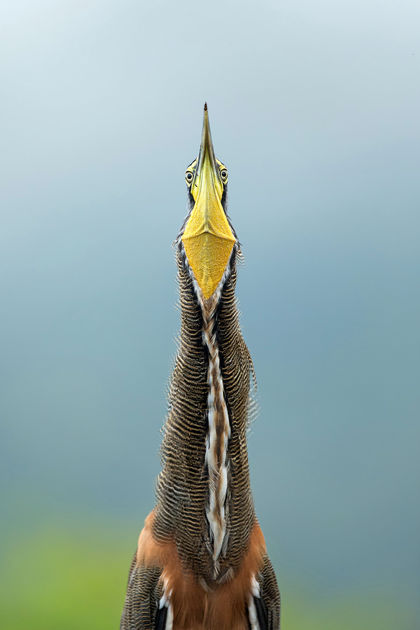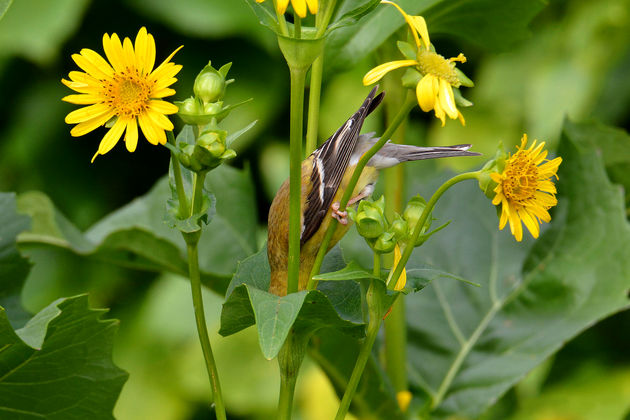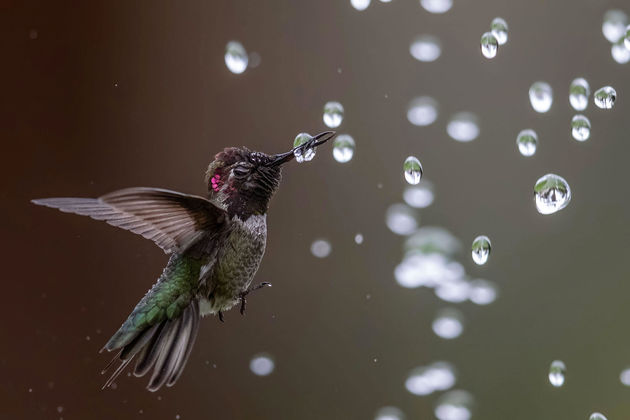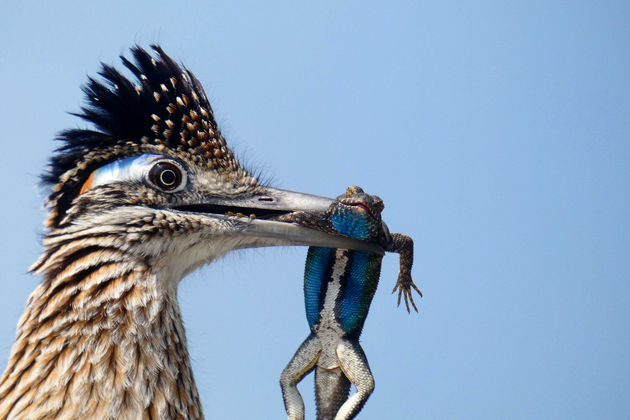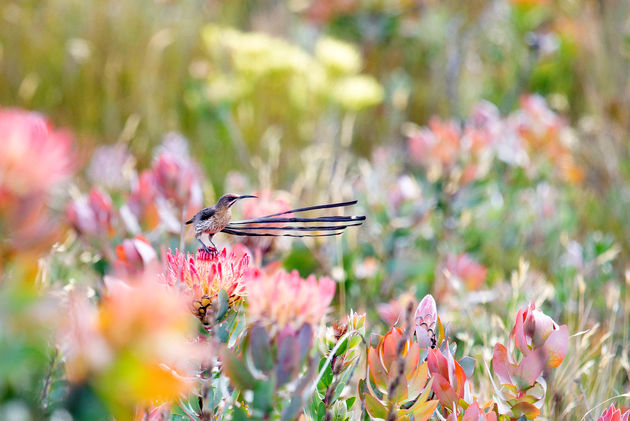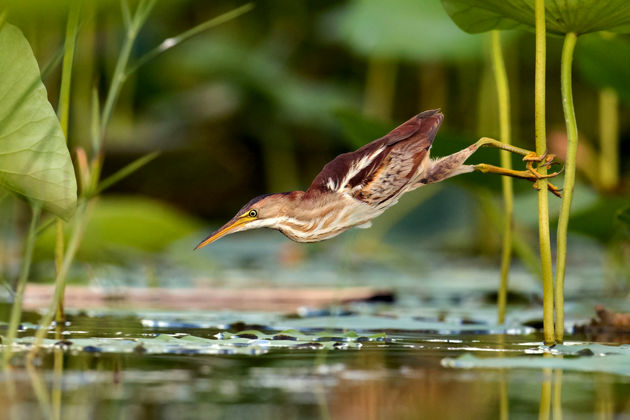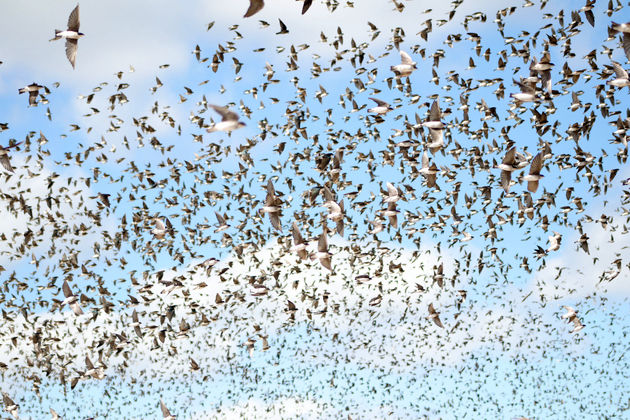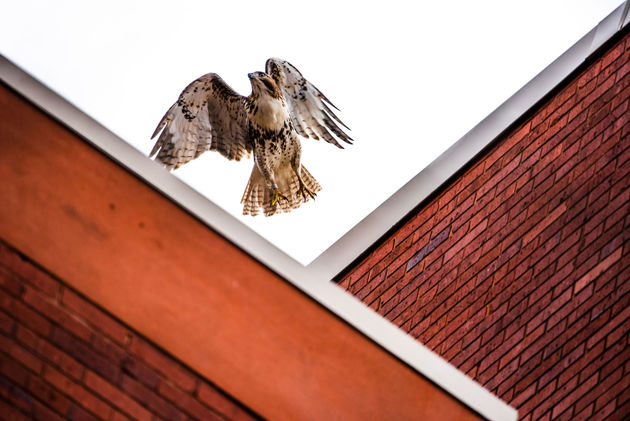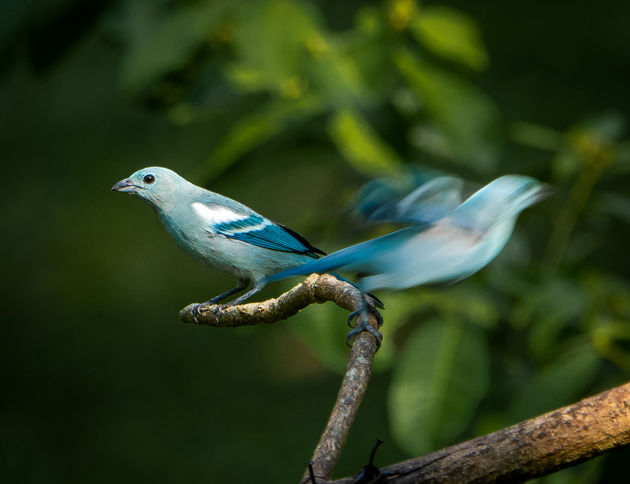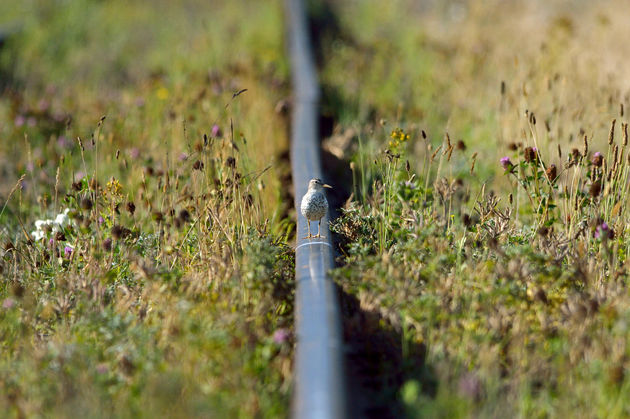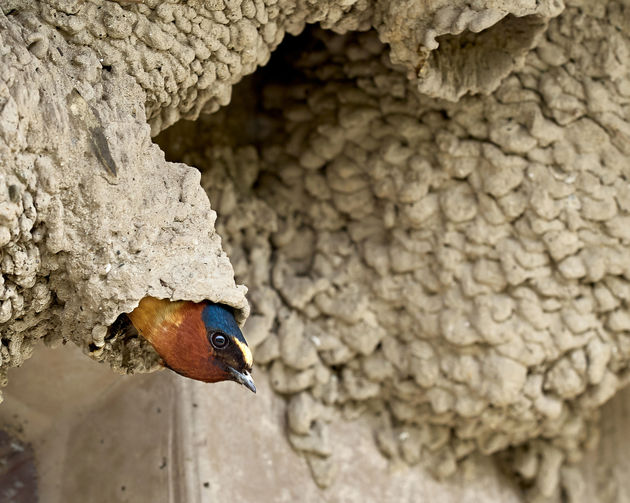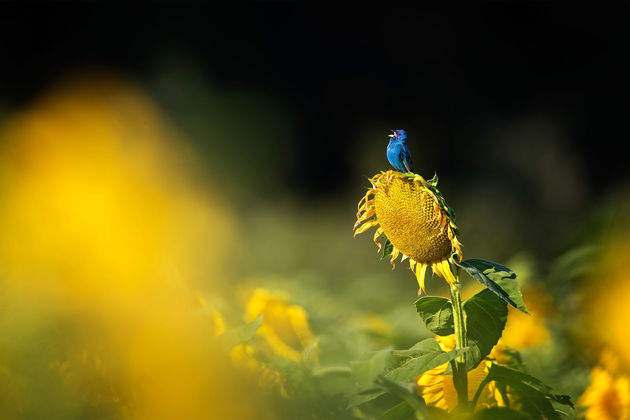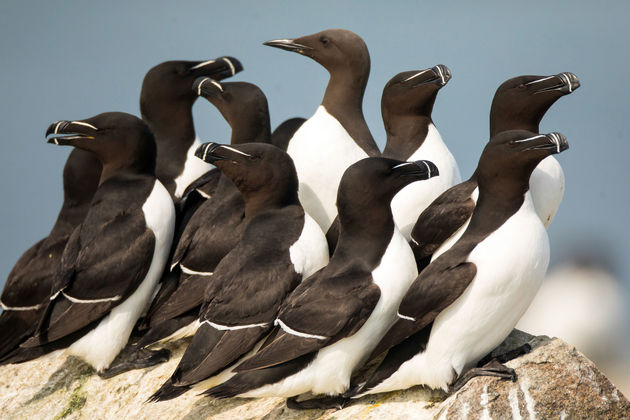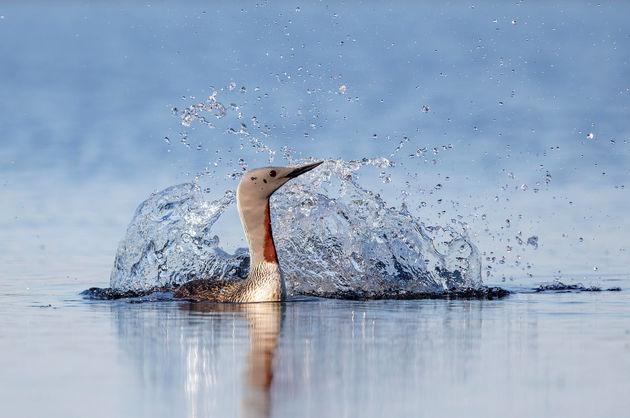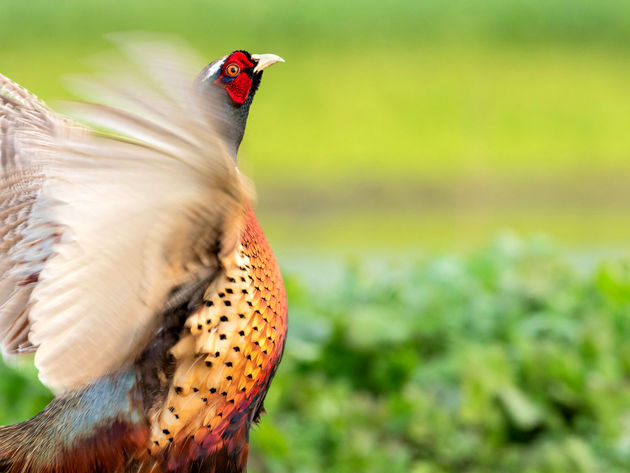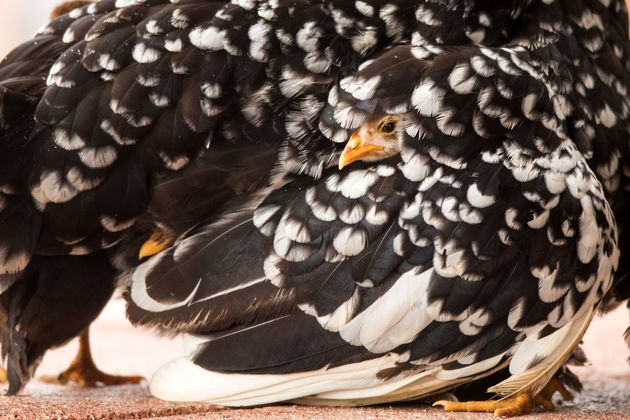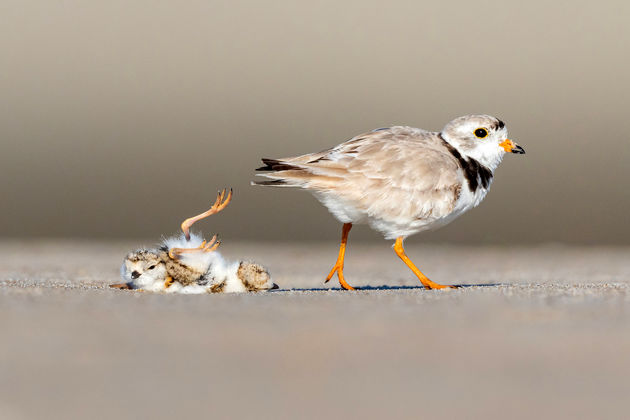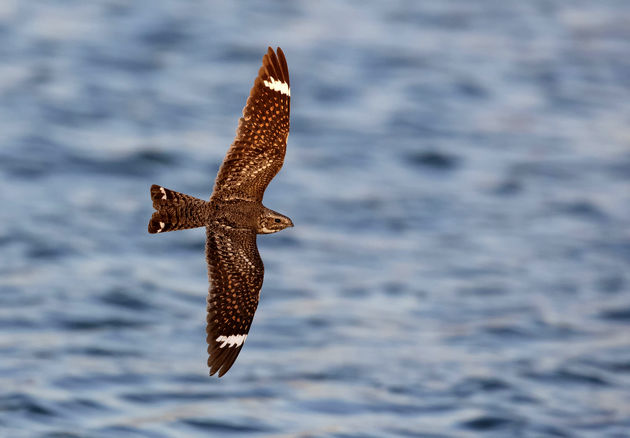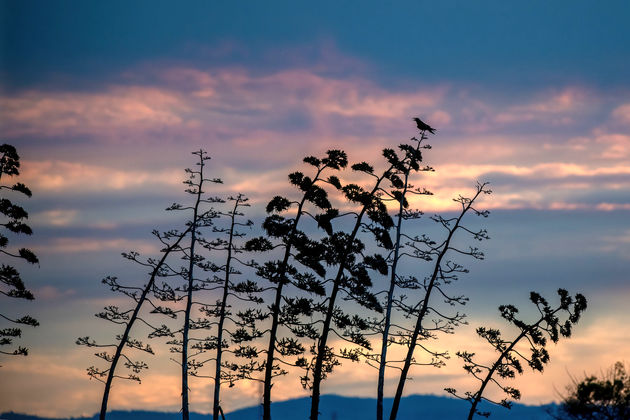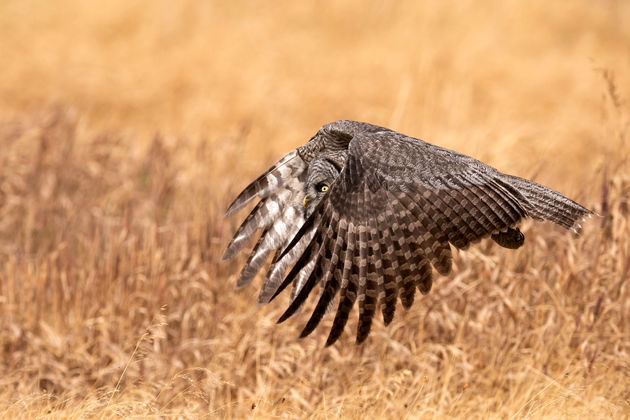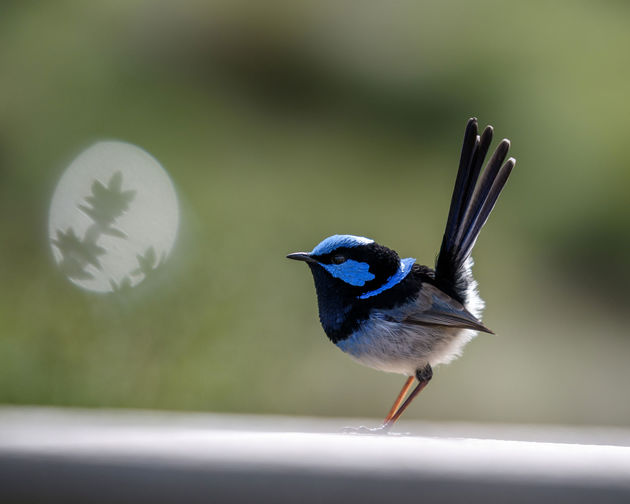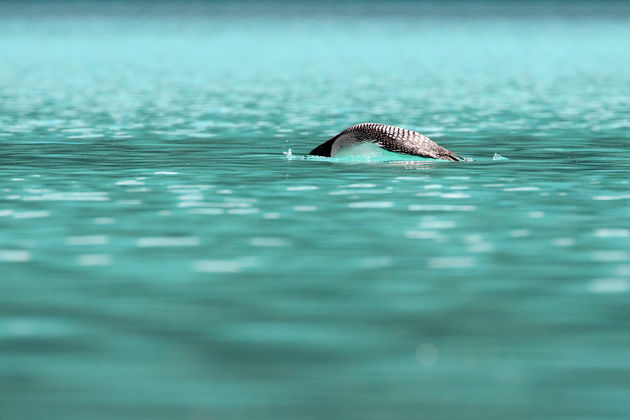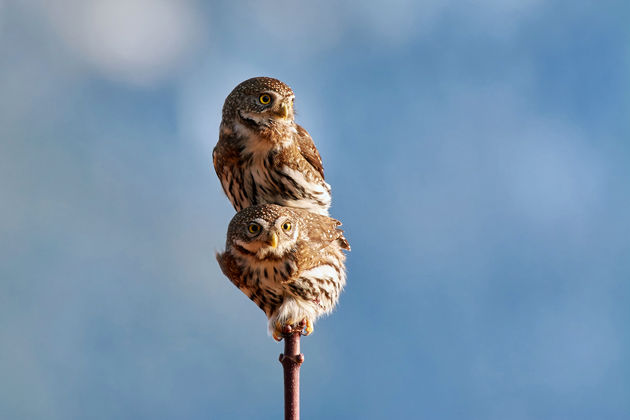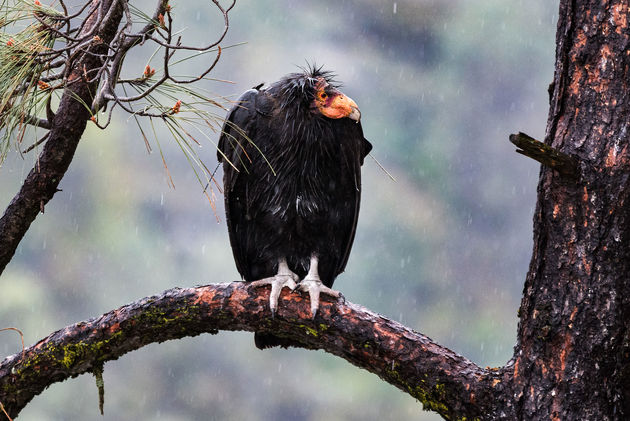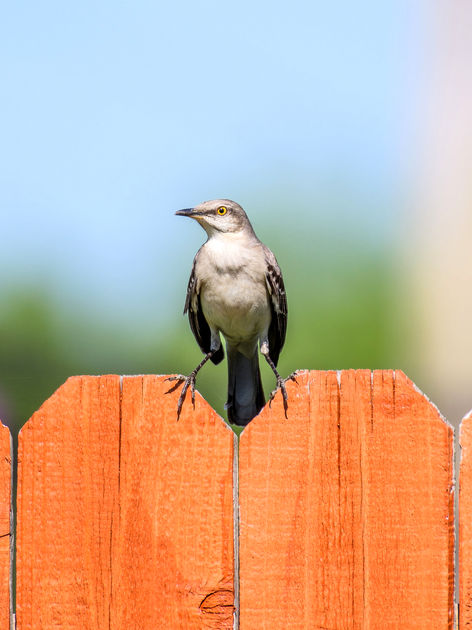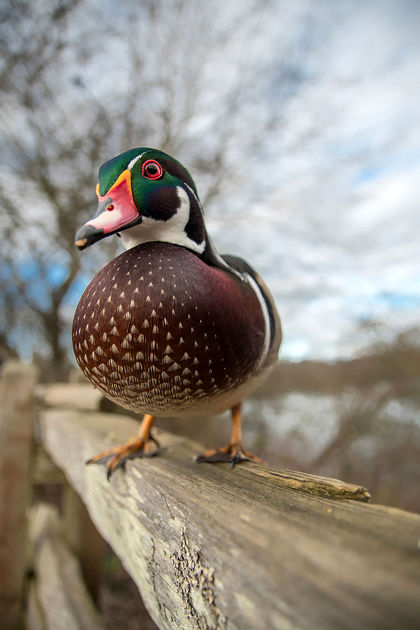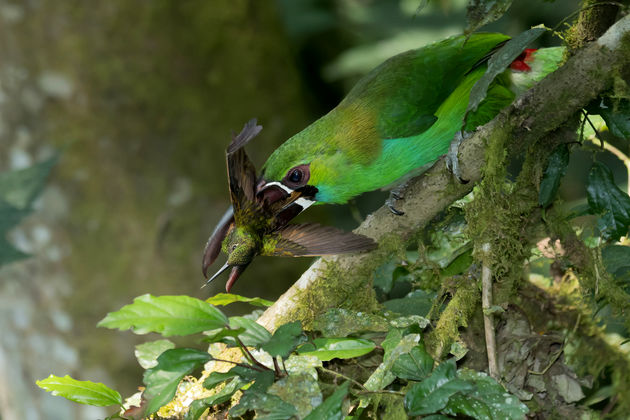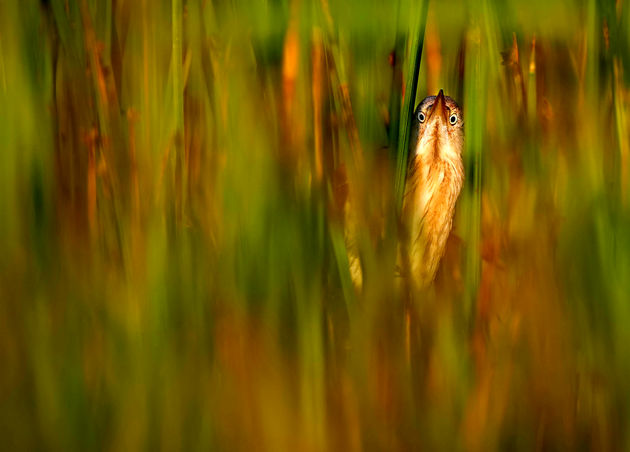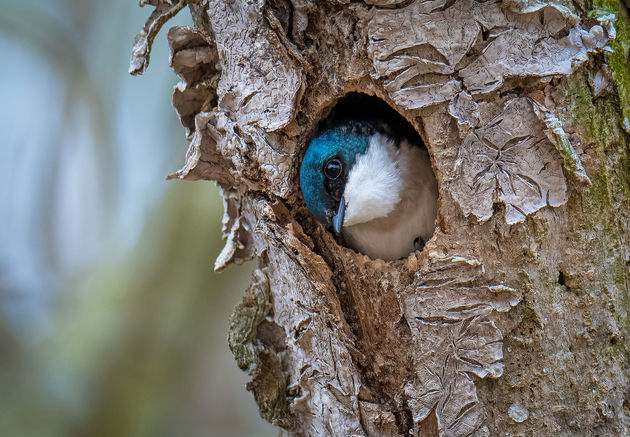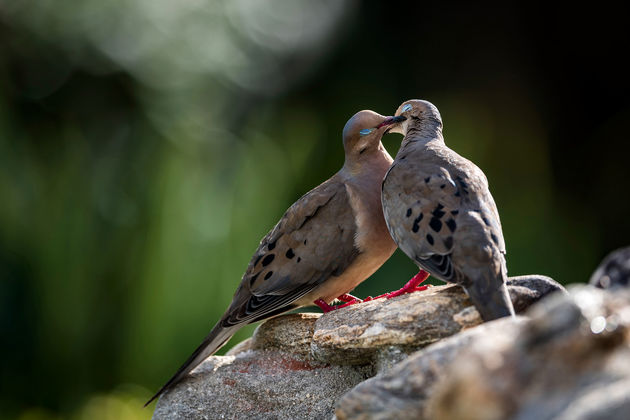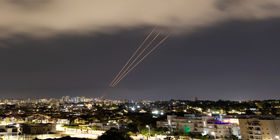پرندگان اعجابانگیز| عکسهای برگزیده جشنواره جهانی آدوبُن ۲۰۲۰
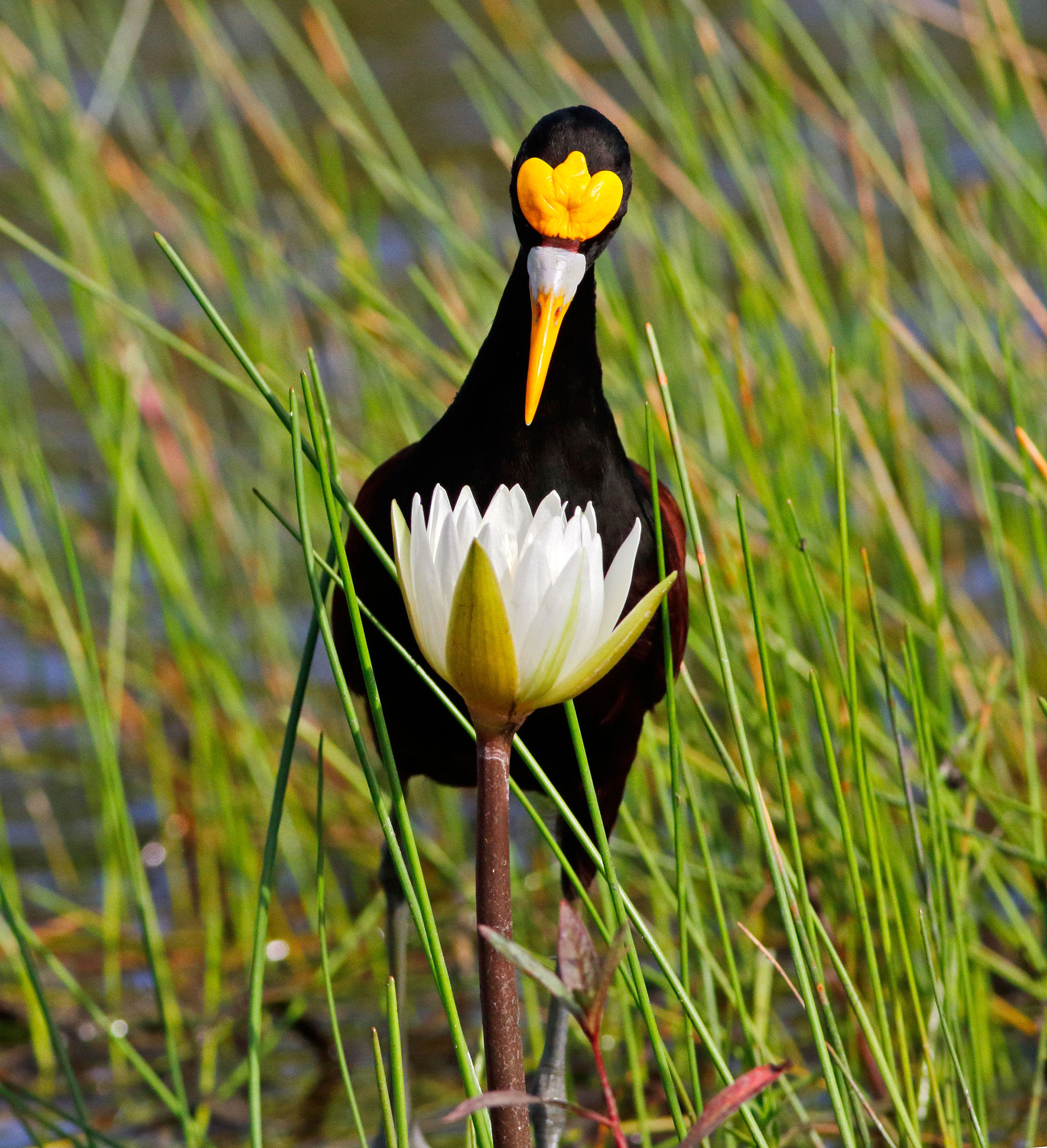
به گزارش اقتصادنیوز، عکاسان در چهار دسته حرفهای، آماتور، جوانان، و گیاهان برای پرندگان در این مسابقه عکاسی شرکت کردند. بیش از 6000 عکس از همه 50 ایالت و هفت استان کانادا و مورد ارزیابی قرار گرفتند. برندگان بخشهای مختلف مسابقه در ابتدا و سپس ۱۰۰ تصویر برگزیده جشنواره عکاسی آدوبُن را به همراه نام عکاس، مشخصات فنی و اختصاصی و دیگر توضیحات مربوطه به زبان انگلیسی در زیر هر تصویر درج شده است.
Grand Prize Winner: Joanna Lentini

Category: Professional
Species: Double-crested Cormorant
Location: Los Islotes, Mexico
Camera: Canon EOS 7D Mark II with Tokina 10-17mm f/3.5-4.5 AT-X 107 DX AF Fisheye lens; 1/640 second at f/6.3; ISO 320
Story Behind the Shot: I’ve spent many hours underwater at this California sea lion rookery in the Bay of La Paz, but I had never before encountered diving cormorants there. Shifting my focus from the playful sea lions, I watched in awe as the cormorants plunged beak-first into the sea to snap at the sardines swimming by. Although I spent a long time admiring these birds, I didn’t see a single one catch a fish. Adding insult to injury, curious sea lion pups would zip by the hunting birds and nip at them from behind.
Bird Lore: Cormorants are superb divers, well adapted to rapid pursuit of fish underwater. Their bodies are heavy but streamlined, with dense plumage. When they dive, they hold their wings tightly to their sides, propelling themselves with their powerful legs and webbed feet, steering through the water with their tails. Some cormorants may be capable of diving more than 300 feet below the surface, but most of their hunting is done at shallower depths.
Fisher Prize Winner: Marlee Fuller-Morris

Category: Amateur
Species: American Dipper
Location: Yosemite National Park, California
Camera: Canon EOS 70D with Canon EF 100-400mm f/4.5-5.6L IS II USM lens; 1/2000 second at f/5.6; ISO 800
Story Behind the Shot: I followed a little-known trail in Yosemite to the top of a small waterfall and sat at the edge of the pool. A moment later, a dipper flew in. The river was moving quickly, but it wasn’t too deep. So instead of diving, the bird stuck its head underwater in search of prey. I thought the spectacular splash would make an awesome photo. The bird kept getting closer and closer as I sat snapping hundreds of shots of that splash. I will treasure that afternoon as one of my favorite moments in Yosemite!
Bird Lore: The American Dipper lives on the edge—on the boundary between air and water, on the border between streams and their banks, and even on that vague margin between songbirds (it is one, technically) and water birds. Above the surface or below, it can either walk or fly, demonstrating a mastery of all its elements, and attracting the admiration of the most creative photographers.
Amateur Winner: Gail Bisson

Bare-throated Tiger-Heron. Photo: Gail Bisson/Audubon Photography Awards
Species: Bare-throated Tiger-Heron
Location: Tárcoles River, Costa Rica
Camera: Canon EOS-1D X with Canon EF 600mm f/4L IS III USM lens; 1/800 second at f/4.0; ISO 1600
Story Behind the Shot: After a torrential rainstorm, I went out on a late-afternoon boat trip on the Tárcoles River. It was still raining when we left the boat ramp, but once the sky finally cleared, we spotted this Bare-throated Tiger-Heron walking along the river. As the boat drifted by, the bird leaned over the bank to watch us. I raised my camera and quickly switched to a portrait orientation to capture the beautiful post-storm sky behind it.
Bird Lore: Stocky and chunky, suggesting bitterns in shape, the three species of tiger-herons lurk in mangrove swamps and along rivers in the American tropics. The Bare-throated Tiger-Heron is the northernmost of these species, found mainly from Mexico to Panama. It is often most active at dawn and dusk, but fortunate observers sometimes spot one hunting fish and frogs in bright daylight.
Plants for Birds Winner: Travis Bonovsky

Species: American Goldfinch
Location: Minneapolis, Minnesota
Camera: Nikon D7100 with Tamron SP 150-600mm F/5-6.3 Di VC USD Model A011 lens; 1/160 second at f/10.0; ISO 320
Story Behind the Shot: Through frequent visits to North Mississippi Regional Park, an area restored with native plants, I became familiar with the cup plant and learned that its leaves can hold rainwater, as the name suggests. I read that birds and other wildlife like to drink from these plants, so I always keep an eye out for bird activity when I pass by them. Finally one late July day I was lucky enough to witness a female American Goldfinch plunge her head into a plant.
Bird Lore: Few birds are total vegetarians, but American Goldfinches come close. While other seed eaters feed their young on insects, goldfinches serve mashed-up seeds to their nestlings. The flowers on this cup plant will go to seed later, but in the meantime the plant acts as a watering hole for the birds: Its large, opposite leaves, joined at their bases, surround the stem and create the rain-trapping cup.
Professional Winner: Sue Dougherty

Species: Magnificent Frigatebird
Location: Genovesa Island, Ecuador
Camera: Canon EOS 7D Mark II with Canon EF 100-400mm f/4.5-5.6L IS II USM lens; 1/1250 second at f/8.0; ISO 1250
Story Behind the Shot: The sun was setting behind a frigatebird breeding colony in the Galápagos. The birds were very active and stunningly close, and the experience was all the more special because I was with great friends who were equally mesmerized by the scene. We got on the sand, lying on our bellies and handholding our cameras, composing silhouettes and starbursts on birds’ wingtips. I noticed this male, with his throat pouch lit up by the sun, and zoomed in to capture his portrait.
Bird Lore: Frigatebirds are among the most aerial of all birds, by necessity: Seabirds that don’t swim, they are almost incapable of taking off from the water’s surface, so they soar on long, angular wings over tropical seas, sometimes for weeks. Males in courtship displays inflate huge, balloon-like red throat pouches, vibrate their wings, and make rattling noises to attract females.
Youth Winner: Vayun Tiwari

Northern Jacana. Photo: Vayun Tiwari/Audubon Photography Awards
Species: Northern Jacana
Location: New River, Orange Walk District, Belize
Camera: Canon EOS 7D Mark II with Canon EF 100-400mm f/4.5-5.6L IS II USM lens; 1/320 second at f/5.0; ISO 1250
Story Behind the Shot: On a boat ride on the New River, I noticed a few Northern Jacanas on a patch of water lilies and asked the captain to stop. I hoped our vessel wouldn’t scare away the birds. I couldn’t believe my luck when one walked closer and closer to us. The boat was rocking, but when the bird stopped for a moment to peer into a water lily, I was able to set up and get this special shot.
Bird Lore: Distinctive marsh birds of the tropics, jacanas have very long toes, enabling them to walk across floating vegetation as they seek insects and seeds. The Northern Jacana is common from Mexico to Panama and the Caribbean, and sometimes wanders to Texas.
Amateur Honorable Mention: Bibek Ghosh

Species: Anna’s Hummingbird
Location: Ardenwood Historic Farm, California
Camera: Fujifilm X-T3 with Canon 600mm f/4L II lens and Fringer EF-FX Pro II Lens Mount Adapter; 1/4000 second at f/4.0; ISO 3200
Story Behind the Shot: Near my home in Fremont is a historic farm with a water fountain that’s a magnet for birds. I was by the fountain looking for warblers and other migrants when I saw this hummingbird, a year-round resident, exhibiting some very interesting behavior. It swooped in for a drink and then stuck around to play in the water, as if trying to catch a droplet. After several frames, I finally captured the bird succeeding at its game.
Bird Lore: Human activities aren’t always beneficial for birds, but Anna’s Hummingbird has taken full advantage of changes we’ve made to the landscape. Formerly a resident of Southern California and Baja, it has expanded its breeding range east, to Arizona, and north, to British Columbia. Planting of year-round gardens has allowed it to thrive across this vast new territory.
Youth Honorable Mention: Christopher Smith

Species: Greater Roadrunner
Location: San Joaquin River Parkway, California
Camera: Panasonic Lumix FZ80 4K with 60X Zoom DC VARIO 20-1200mm f/2.8-5.9 lens; 1/500 second at f/5.6; ISO 200
Story Behind the Shot: While on a walk through a nature preserve in Fresno, I heard a roadrunner cooing to its mate. I followed the sound to find the bird clutching a gift for its partner: a really big fence lizard! The roadrunner perched on a post above me for nearly 10 minutes. The lighting was harsh and it was difficult to get the proper camera setting, but I managed to take this shot. I like how the photograph shows a small predator with its prey.
Bird Lore: Ritualized feeding is a part of courtship for many birds, from cardinals to gulls to hawks. For the Greater Roadrunner, it’s no challenge for the male to catch a lizard to give to the female. At times, though, he will present to her a large insect or a piece of nest material, or go through the motions of bestowing a gift with nothing at all. Apparently, it’s the thought that counts.
Plants for Birds Honorable Mention: Natalie Robertson

Tennessee Warbler. Photo: Natalie Robertson/Audubon Photography Awards
Species: Tennessee Warbler
Location: Point Pelee National Park, Ontario, Canada
Camera: Canon 7D Mark II with Sigma 150-600mm f/5-6.3 DG OS HSM Contemporary lens; 1/1000 second at f 6.3; ISO 500
Story Behind the Shot: This warbler was difficult to photograph as it frantically hopped from branch to branch while foraging on a native gooseberry—one of the plants that flower in early spring in this part of Canada. Gooseberries are an important source of food for exhausted songbirds migrating north over the Great Lakes, and I was thrilled to get a clear image of this warbler drinking nectar from the tiny flowers.
Bird Lore: Warblers are mainly insect eaters, but some also have a taste for nectar. On their main wintering grounds in Central America, Tennessee Warblers often show splashes of bright color on their faces, the result of probing in red or orange flowers. Their attraction to nectar continues as they migrate north. In the open woods of southeastern Canada and northern states, the inconspicuous blooms of eastern prickly gooseberry appear in late spring, just in time for migrating warblers to seek them out.
Professional Honorable Mention: Gene Putney

Species: Greater Sage-Grouse
Location: Jackson County, Colorado
Camera: Nikon D500 with AF-S VR Zoom-Nikkor 200-400mm f/4G IF-ED lens; 1/400 second at f/5.6; ISO 1600
Story Behind the Shot: In spring 2019 I made my first venture to watch the Greater Sage-Grouse perform its courtship ritual. Late one afternoon
I set up my camera at the edge of a rural road and used my car as a blind. This male was the first bird I saw, and he proved to be a great model. As he faced away from me, he provided a nice profile pose, and I thought it was a neat perspective to get his photo from behind.
Bird Lore: After their spectacular springtime courtship dances, Greater Sage-Grouse seem to disappear into the vast sagebrush steppes of the West. Studies have shown that they may move many miles with the seasons, often shifting to higher elevations in summer, lower elevations in winter, so they need large, continuous tracts of habitat to survive.
Other 100 Top Photos
.

Category: Amateur
Photographer: Andrew Lee
Species: Burrowing Owl
Location: Ontario, CA
Camera: Nikon D810 with Nikon AF-S NIKKOR 300mm f/2.8G ED VR II lens and Nikon AF-S Teleconverter TC-14E III; 1/640 second at f/5.6; ISO 2000
Behind the Shot: For days I tried to capture a portrait of the eight youngsters and parents of this large owl family. They never gathered all together, but one beautiful morning I was happy to see for the first time the mother with her eight owlets. I took a few images of them looking in all directions. Then, suddenly, they all turned and looked toward me, and I quickly snapped an image of the precious moment.

Category: Amateur
Photographer: Cameryn Brock
Species: Cape Sugarbird
Location: Blue Hill Nature Reserve, Western Cape, South Africa
Camera: Nikon D600 with Nikon AF-S NIKKOR 300mm f/4E PF ED VR lens and Platinum 77mm UV filter; 1/800 second at f/4.5; ISO 500
Behind the Shot: While working at a field station in the fynbos region of South Africa, I spent the day hiking around. On my last day I found a nice rock to sit on among the blooming proteas and ate my peanut butter and jelly sandwich with the sugarbirds chasing each other around me. With the lovely blooming flowers and active birds, I extended my lunch break to soak up the last of my time in the fynbos and take a few final photos.

Category: Professional
Photographer: Peter Brannon
Species: Least Bittern
Location: Lakeland, FL
Camera: Nikon D500 with Nikon AF-S NIKKOR 500mm f/4D IF-ED lens; 1/1600 second at f/5.6; ISO 1400
Behind the Shot: At a Florida lake, I found this Least Bittern hunting in the aquatic vegetation close to shore. I got on my belly at the water’s edge and maneuvered my lens to get a clear shot of the bird through the lush greenery. I watched as it spotted a fish in the water and made this long extension to try and grab it, almost at a 90-degree angle from the plant’s stem. My favorite part of photographing birds is witnessing these extraordinary moments that fill me with surprise and wonder.

Category: Amateur
Photographer: Matt Filosa
Species: Piping Plover
Location: Parker River National Wildlife Refuge, Ipswich, MA
Camera: Canon 7D Mark II with Canon EF 600mm f/4L IS II lens and Canon Extender EF 1.4x III; 1/1250 second at f/7.1; ISO 1000
Behind the Shot: A brood of Piping Plovers came very close to where I lay in the sand. I wanted to capture the classic scene of the full brood huddling under their parents, but I was too close for that. Instead, I tilted the lens downward and noticed the contrast of all those little orange legs against a black background (I think a patch of seaweed). The picture reminds me of a crowded bar.
Note: These endangered birds were photographed with a very long lens and teleconverter. Please give these birds the space they need to safely feed and rest.

Category: Youth
Photographer: Josiah Launstein
Species: American Robin
Location: Pincher Creek, Alberta, Canada
Camera: Nikon D7100 with Nikon AF-S NIKKOR 200-500mm f/5.6E ED VR lens; 1/320 second at f/7.1; ISO 640
Behind the Shot: I was about to sit down for dinner when I glanced out the front window and noticed this young robin tucked into the vines on our deck. It alternated between grooming itself and calling out for a meal. I quickly grabbed my camera gear and snuck out the door on the opposite side of the house. I wanted to backlight the robin, so I cautiously approached from the east. Once I was in position, I leaned up against the house for extra stability and squeezed off this shot. Before too long, the robin’s mom came back and dropped an insect into the youngster’s beak!

Category: Youth
Photographer: Anastasia Stefanou
Species: Sanderling
Location: Jones Beach State Park, NY
Camera: Canon EOS 5D Mark IV with Canon EF 400 mm f/5.6 lens; 1/80 second at f/8; ISO 800
Behind the Shot: I took a two-hour drive on a frigid November afternoon in search of Snowy Owls. On a sunset walk to the end of the beach, a flock of Sanderlings descended in front of me. I was eager to capture the birds in their ebb-and-flow dance with the waves. I crouched low to frame the birds escaping the crashing wave. Although we didn’t see any owls, it was well worth the trip.

Category: Amateur
Photographer: Lisa Sproat
Species: Whooper Swans
Location: Akan National Park, Teshikaga, Hokkaido, Japan
Camera: Canon EOS 5D Mark IV with Canon EF 70-200mm f/2.8L USM lens; 1/1250 second at f/2.8; ISO 125
Behind the Shot: Beautiful, noisy Whooper Swans overwinter in Hokkaido, taking advantage of the (relatively) warm waters of this caldera lake. Early in the day, the water was calm, and the swans drifted through the mist. The afternoon brought storm clouds and a relentless, cold wind. This pair is trumpeting and displaying with great energy after they were victorious in a scuffle that sent another swan couple packing.

Category: Youth
Photographer: Joseph Salmieri Jr.
Species: Tree Swallow
Location: Cape May County, NJ
Camera: Canon EOS 80D with Canon EF 75-300mm f/4-5.6 III lens; 1/5000 second at f/4; ISO 1000
Behind the Shot: Tree swallows were everywhere. When the whole flock was in the sky, all I could hear was their twittering and wing beats. It was an epic sight to witness. The biggest challenge was capturing the frenzy in the air without filling the frame with too much activity, nor leaving out too much. This is only a small portion of the entire flock.

Category: Amateur
Photographer: Shay Saldana
Species: Florida Scrub-Jay
Location: Helen and Allan Cruickshank Sanctuary, Rockledge, FL
Camera: Canon EOS 5D Mark IV with Canon EF 100-400mm f/4.5-5.6L IS II USM lens; 1/160 sec at f/5; ISO 100
Behind the Shot: I visited this sanctuary a week after a prescribed burn, conducted to maintain the natural scrub habitat. It had just rained, and I soon found a family of Florida Scrub-Jays hopping around a burned brush. I kneeled in the mud to get a low shot and nearly fell over. Then one hopped out of the brush and began to bathe in the water in front of me, stopping once just to look at me. I took this photo while lying on the ground, soaking wet, happy to be with these curious birds.

Category: Amateur
Photographer: Julian Aaron Jacobs
Species: Red-tailed Hawk
Location: George Washington University, Washington, D.C.
Camera: Nikon D810 with Sigma 150-600mm 5-6.3 Contemporary DG OS HSM lens; 1/1000 second at f/6.3; ISO 500
Behind the Shot: I was unprepared when I first ran into this hawk. I was on my way back from class and didn’t have my camera. I ran to my fraternity house, grabbed my gear, and sprinted back, but the bird had vanished. Every day I searched for the hawk on my commute to class. I even recruited my fraternity brothers to report any signs of large birds. It was a long shot, but a steady stream of sightings came in. Finally, I had my camera when the hawk flew in once again. Heart racing, I brought the viewfinder to my eye and got this shot of its takeoff.

Category: Amateur
Photographer: Peter Hogan
Species: Blue-gray Tanager
Location: Manu Biosphere Reserve, Peru
Camera: Sony Alpha a6400 with Sony FE 100-400mm f/4.5-5.6 GM OSS lens; 1/125 second at f/7.1; ISO 100
Behind the Shot: On a trip to a remote lodge in the rainforest of Peru, after hiking around during the day, we would sit on the veranda in the late afternoon. Sipping whiskey, I would gaze out at the local birds, including a number of tanagers. I didn’t bring a tripod or a monopod on the trip, so a railing served as a handy camera platform.

Category: Amateur
Photographer: Breanna Wilson
Species: Spotted Sandpiper
Location: Squamish, British Columbia, Canada
Camera: Nikon D3200 with Sigma 150-500 mm F/5-6.3 APO DG OS HSM lens; 1/2500 second at f/6; ISO 400
Behind the Shot: A pair of sandpipers built a nest between a set of old train tracks that runs through a local estuary. Once news got out, many local birders let others know to be cautious around the area. When the babies hatched, they were so tiny they couldn’t get over the tracks to reach the water. Someone made a ramp out of wood to help, and the chicks were off soon after. It warmed my heart to see how many people came together to help this little family.

Category: Amateur
Photographer: Kali Blevins
Species: Cliff Swallow
Location: Bear River Migratory Bird Refuge, Corinne, UT
Camera: Olympus OMD E-M5 Mark I with Olympus M.Zuiko DIGITAL ED 40-150mm f/2.8 PRO lens; 1/160 second at f/4.5; ISO 200
Behind the Shot: Cliff Swallow nests cover every inch of available overhang at this refuge. The birds construct their nests from mud, carried beakful by beakful. I was marveling at this impressive infrastructure when this bird peeked out of its nest. The moment made braving the swarms of mosquitoes totally worth it.

Category: Amateur
Photographer: Howard Arndt
Species: Ruby-throated Hummingbird
Location: Amherst, NH
Camera: Canon EOS 1DX Mark II with Canon EF 800mm f/5.6L IS USM lens and Canon Extender 2x EF III; 1/640 second at f/18; ISO 5000
Behind the Shot: I first saw this bird sitting on the dead branch of an oak tree outside my front door. That day I spent eight hours with him, taking thousands of photos. I was taught to stay with an interesting subject, and this one fascinated me; over two months I observed him fighting, facing off with a spider, bathing in the rain, grooming, and sleeping. In this shot, he’s doing his stretching exercises at his favorite perch. Using my house as a blind, I took the photo from an open window. After much experimentation, I pre-focused on the branch and used a cable release to activate the shutter.

Category: Amateur
Photographer: Scott Suriano
Species: Indigo Bunting
Location: Mckee Beshers Wildlife Management Area, Montgomery County, MD
Camera: Canon EOS 1DX Mark II with Canon EF 500mm f/4L IS II USM lens and Canon Extender EF 1.4x III; 1/1250 second at f/5.6; ISO 400
Behind the Shot: I arrived at this sunflower field at sunrise to find several species of songbirds flying around and feasting on seeds. Among them were several brightly-colored Indigo Buntings, feverishly competing with American Goldfinches for real estate among the large yellow sunflowers. I saw this particular bunting take up residence on a weary sunflower head and triumphantly belt out his song across the fields. To capture the scene, I positioned myself to include the colorful foreground and situated the bird against the dark background so it would stand out. As I took the photos, the bird kept singing, its melody ringing across the field.

Category: Youth
Photographer: Izzy Edwards
Species: Great Gray Owl
Location: Mountain View County, Alberta, Canada
Camera: Canon 7D Mark II with Sigma 150-600mm 5-6.3 Contemporary DG OS HSM lens; 1/1000 second at f/7.1; ISO 800
Behind the Shot: On a cold morning in Alberta, my best friend and I got up early to search for the elusive Great Gray Owl. We went up and down farm roads before coming across this magnificent individual perched on a post. It soon retreated into the snow-covered forest, and I assumed we wouldn’t be seeing it again. To my surprise, the owl re-emerged and landed on a small conifer. That’s when a tiny feather floated to the ground. I really love this photo because it looks as if the owl is staring at its feather drifting through the frigid morning air.

Category: Amateur
Photographer: Joshua Pelta-Heller
Species: Common Murre, Razorbill
Location: Machias Seal Island, Grand Manan, New Brunswick
Camera: Canon EOS 5D Mark IV with Canon EF 800mm f/5.6L IS USM lens; 1/4000 second at f/5.6; ISO 640
Behind the Shot: During an early summer trip to photograph seabirds of Machias Seal Island, this group of Razorbills standing around one Common Murre caught my eye. The scene reminded me of a security detail or one of those clichéd “be original” posters. I wanted to capture the symmetry of the murre flanked on either side by four Razorbills, but I knew I would only have a few seconds before the birds would shift positions. This frame ended up being my favorite, with almost all of the Razorbills on each side looking in their respective directions.

Category: Amateur
Photographer: Shirley Donald
Species: Red-throated Loon
Location: Nome, AK
Camera: Canon EOS 5D Mark IV with Canon EF 400mm f/4 DO IS II USM lens and Canon Extender EF 1.4x III ; 1/2000 second at f/6.3; ISO 640
Behind the Shot: Early one morning on a trip to Alaska, I was delighted when our birding guide spotted a pair of these graceful Red-throated Loons that had taken up residence in one of the many ponds outside Nome. We crept to the water’s edge, lay down, and for more than an hour were treated to an amazing display of synchronized swimming, courtship behavior, and territorial antics. There are actually two loons in this photo. The second loon had just made a deliberately large, noisy dive as part of its territorial display.

Category: Amateur
Photographer: Karl Schneider
Species: Ring-necked Pheasant
Location: Sacramento National Wildlife Refuge, Willows, CA
Camera: Olympus OM-D E-M1 Mark II with Olympus M.Zuiko Digital ED 300mm F4.0 PRO lens; 1/200 second at f/4.5; ISO 1000
Behind the Shot: As a student, I often find it challenging to wake up for my early-morning classes. But when birds are involved, getting up is not a problem. This morning I was up before dawn to drive to a wildlife refuge in hopes of seeing a visiting Golden Eagle. I was soon sidetracked by this male Ring-necked Pheasant on full display for the mating season. I took this shot just after sunrise. I think the blurred-out wings give the photo a serene feeling, which is exactly how I felt watching these gorgeous birds.

Category: Amateur
Photographer: Jill Bartelt
Species: Waved Albatross
Location: Española Island, Ecuador
Camera: Canon EOS Rebel T2i with Canon EF 70-300mm f/4-5.6 IS USM lens and B+W 67mm UV Haze MRC 010M filter and Canon ET-73B lens hood; 1/160 second at f/5.6; ISO125
Behind the Shot: On a trip to the Galápagos Islands, we stopped at Española Island, a nesting site for virtually all of the world’s Waved Albatrosses. I was instantly captivated by these charismatic seabirds with their liquid black eyes and tufted eyebrows. As I watched their courtship displays, I learned the patterns of bows and beak-clacking, and timed my shots to capture specific scenes. At one point, this bird seemed to look right at me!

Category: Amateur
Photographer: Joshua Pelta-Heller
Species: Feral Chicken
Location: Virgin Islands National Park, St. John, Virgin Islands
Camera: Canon EOS 5D Mark IV with Canon EF 800mm f/5.6L IS USM lens; 1/250 second at f/5.6; ISO 1250
Behind the Shot: On a visit to the national park in the Virgin Islands, we got stuck in an afternoon rainstorm almost as soon as we left the visitor center. We ended up spending two hours under a pavilion in the parking lot, where I spotted several feral chickens. I photographed the birds as they foraged, accompanied by their newborn chicks, like this one, which were looking for some cover from the storm, too.

Category: Amateur
Photographer: Matt Filosa
Species: Piping Plover
Location: Parker River National Wildlife Refuge, Ipswich, MA
Camera: Canon 7D Mark II with Canon EF 600mm f/4L IS II and Canon Extender EF 1.4x III; 1/3200 second at f/7.1; ISO 640
Behind the Shot: Piping Plovers can leave the nest and feed for themselves a few hours after they’re hatched, but they often need to huddle under their parents for warmth in the first few days of their lives. While watching this behavior, I noticed there’s sometimes a bit of chaos when the parent decides they’ve had enough. I wanted to try and capture that moment, and I especially like this shot—it reminds me of a busy parent dropping off the kids at school.
Note: These endangered birds were photographed with a very long lens and teleconverter. Please give these birds the space they need to safely feed and rest.

Category: Amateur
Photographer: Scott Suriano
Species: Roseate Spoonbill
Location: J.N. Ding Darling National Wildlife Refuge, Sanibel Island, FL
Camera: Canon EOS 5D Mark IV with Canon EF 500mm f/4L IS II USM lens and Canon Extender EF 1.4x III; 1/1250 second at f/5.6; ISO 1250
Behind the Shot: On a sunrise drive in a Florida park, I noticed this Roseate Spoonbill hunting in the brackish shallows on the edge of a large stand of mangroves. The light hitting the mangroves, reflected in the water and illuminating the bird, was nothing short of magical. I jumped out of my car, positioned myself as low as possible, and framed the shot in an effort to do this fantastic scene justice.

Category: Professional
Photographer: Nate Chappell
Species: Lesser Nighthawk
Location: Amado Wastewater Treatment Plant, Amado, AZ
Camera: Canon EOS 5D Mark III with Canon EF 500mm f/4L IS II USM lens; 1/1600 second at f/5.6; ISO 1250
Behind the Shot: We were watching dozens of nighthawks hunting insects at the water treatment plant right before sundown. The birds fly very fast and erratically, like big swallows, so they’re difficult to focus on. I managed to get this bird in focus, with the full topside in view, just before we lost good light for the evening.

Category: Amateur
Photographer: Trish Lyon
Species: Common Raven
Location: American Canyon Wetlands Open Space, American Canyon, CA
Camera: Nikon D850 with Nikon AF-S NIKKOR 300mm f/2.8G ED VR II lens and Nikon AF-S Teleconverter TC-14E III; 1/2500 second at f/4; ISO 400
Behind the Shot: I was leaving a nearby wetland, where a local grassfire had filled the sky with smoke. The sun had nearly disappeared when I heard the unmistakable call of a raven. Looking around, I found the bird perched on top of a tree line, with the trees nearly bent in half from the wind. I lifted my lens and captured this image of the silhouette before the raven flew off into the evening.

Category: Amateur
Photographer: Mike Madding
Species: Sora
Location: Cattail Marsh, Beaumont, TX
Camera: Canon 7D Mark II with Canon EF 100-400mm f/5.6L IS II USM lens; 1/640 second at f/5.6; ISO 1600
Behind the Shot: After several days visiting a marsh and trying to photograph this secretive little rail, I finally spotted one lurking around some undergrowth, just off the boardwalk. I decided to set up my camera and wait to see if it would make its way toward me. After 20 minutes the bird showed itself and rewarded me with some fine shots.

Category: Amateur
Photographer: Peter Hartlove
Species: Great Gray Owl
Location: Yellowstone National Park, WY
Camera: Nikon D500 with Nikon AF-S NIKKOR 600mm f/4E FL ED VR lens; 1/4000 second at f/5.6; ISO 800
Behind the Shot: I had lost a very close friend recently and wanted to escape to the wilderness of Yellowstone. The night I arrived, a friend told me she’d seen a Great Gray Owl nearby. The next day I was up at the crack of dawn and very excited as I parked my truck close to the sighting area. I looked up through my windshield and was startled to see the owl staring back at me, no more than 30 feet away. I froze, not wanting to scare it. Eventually, I quietly opened the door. Luckily, the owl hardly seemed to notice. I spent the next few hours alone with this bird as it hunted voles. Witnessing its skill and determination touched me deeply.

Category: Amateur
Photographer: David Mollenhauer
Species: Superb Fairywren
Location: Port Campbell National Park, Victoria, Australia
Camera: Nikon D500 with Tamron SP 70-200mm F/2.8 Di VC G2 lens; 1/2500 second at f/2.8; ISO 250
Behind the Shot: While I was stopped at a national park visitor center, this fairywren burst onto the scene. I jumped at the opportunity to take his photo, but he kept dashing off—beneath a bush, behind a woman, under a bench—like he knew he was teasing me! I reset my camera to better capture the bird’s motion, and he finally gave me a chance to take his portrait in front of a handrail six feet away.

Category: Amateur
Photographer: Jory Teltser
Species: Southern Cassowary
Location: Etty Bay, Queensland, Australia
Camera: Canon EOS 1DX Mark I with Canon EF 300mm f/2.8L IS II USM lens; 1/2000 second at f/4; ISO 6400
Behind the Shot: I devoted my last day in Queensland to searching for the prehistoric-looking Southern Cassowary. After some time on the beach, an elderly female emerged from the understory and began walking in my direction. She was tall enough to be at eye level with me. Her pace slowed, and I felt her intense, reptilian gaze. I spent well over an hour with this bird, and she remained unfazed by me and several other beachgoers.

Category: Youth
Photographer: Ashrith Kandula
Species: Common Loon
Location: Yoho National Park, British Columbia, Canada
Camera: Canon EOS 7D Mark II with Canon EF 100-400mm f/4.5-5.6L IS II USM lens and Canon EF 1.4x II Extender; 1/1000 second at f/10; ISO 1000
Behind the Shot: I saw a lone loon dive into the blue-green water of this beautiful glacial lake. When it finally resurfaced, I wasn’t in the right position to take a close shot, so I dashed to another part of the shore. I worried I was too late, but I was thrilled with the photo I ended up with, showing the geometric pattern of the loon as it dove again in the middle of the pristine water.

Category: Amateur
Photographer: Carter Kremer
Species: Snowy Egret
Location: Pleasure Point, Santa Cruz, CA
Camera: Nikon Z6 with Nikon NIKKOR Z 24-70mm f/4 S lens; 1/500 second at f/4; ISO 3200
Behind the Shot: Christmas Eve brought an unusually low tide and beautiful sunset to Santa Cruz. Throngs of people gathered at the beach to watch the scene, and surfers caught their final waves of the day. Away from the crowds, I used the low tide to follow two Snowy Egrets catching all sorts of fish and invertebrates in the tidal pools. I held the camera just an inch or two off of the water and used a short lens that highlighted the sunset just as much as the egret.

Category: Amateur
Photographer: Dan Ion
Species: Semipalmated Sandpiper
Location: DuPont Nature Center, Milford, DE
Camera: Canon EOS 7D Mark II with Canon EF 500mm f/4L IS II USM lens; 1/1000 second at f/9; ISO 800
Behind the Shot: When I visited the Delaware Bay in May, thousands of Semipalmated Sandpipers and other migratory shorebirds were feasting on horseshoe crab eggs along the water’s edge. Every few minutes, large flocks would fly over the area and land back in the same general spot. Some of the birds would lag behind and have a hard time finding a good place to land, like this sandpiper in my photo. It was a very busy place.

Category: Youth
Photographer: Josiah Launstein
Species: Northern Pygmy-Owl
Location: Fraser Valley, British Columbia, Canada
Camera: Nikon D7100 with Nikon AF-S NIKKOR 200-500mm f/5.6E ED VR lens; 1/320 second at f/8; ISO 800
Behind the Shot: I was photographing a female Northern Pygmy-Owl when a male landed on her and immediately mated. I only had to adjust my composition slightly to capture the unexpected action. The expressions of the owls in the photo reminds me of characters on a totem pole—the proud male on top of the female, and the (perhaps unimpressed) look on the female’s face. The male was actually very tender with his mate, and I got some sweet pictures of them together before he flew off.

Category: Youth
Photographer: August Davidson-Onsgard
Species: Bald Eagle
Location: Ninilchik, Kenai Peninsula, AK
Camera: Canon EOS 7D Mark II with Canon EF 400mm f5.6L USM lens; 1/6400 second at f/5.6; ISO 1250
Behind the Shot: The beaches of Ninilchik are often covered in fish carcasses, discarded by the many fishing boats in the area. The abundance of food attracts large numbers of Bald Eagles and other birds to the beaches. I learned that it’s fairly easy to stumble upon an eagle while taking a quick walk down the beach. It was a bizarre experience for me, as someone from a place where eagles are not common.

Category: Amateur
Photographer: Rick Derevan
Species: Acorn Woodpecker
Location: Atascadero, CA
Camera: Canon 1DX Mark II with Canon EF 600mm f/4L IS II lens and Canon EF 1.4x Extender 1.4 extender; 1/2000 second at f/5.6; ISO 1000
Behind the Shot: I was enjoying birdwatching in my backyard when I heard—then spotted—these Acorn Woodpeckers excavating this nest cavity, sometimes joined by a third bird. I set up my camera and spent two hours taking many, many photos. This image is one of my favorites because it shows how these birds cooperate and illustrates the importance of leaving old trees standing. Here, the weakened branch made it easier for the group to excavate the nest hole.

Category: Plants for Birds
Photographer: Bret Nainoa Mossman
Species: ʻIʻiwi (with Hāhāʻaiakamanu)
Location: Kokeʻe State Park, Waimea, Kauaʻi, HI
Camera: Canon EOS 7D Mark II with Canon EF 100-400mm f/4.5-5.6L IS II USM lens; 1/200 second at f/5.6; ISO 320
Behind the Shot: It was an unusually sunny day in one of the wettest places in the world, on Kauaʻi. It also happened to be perfect timing for the blooming of a rare endemic flower called Hāhāʻaiakamanu. Another Hawaiian photographer and I spent nearly eight hours hidden near the flowering plants, watching ʻIʻiwi and another honeycreeper, Kauaʻi ʻAmakihi, feed. Capturing the relationship between this bird and plant was something truly magical—the two evolved together, shaping each other, the place, and the people of Hawaiʻi.

Category: Amateur
Photographer: Mike Ince
Species: California Condor
Location: Pinnacles National Park, CA
Camera: Nikon D750 with Sigma 150-600 mm 5-6.3 Contemporary DG HSM OS lens; 1/400 second at f/6.3; ISO 2500
Behind the Shot: A good friend and I decided to venture into Pinnacles National Park in hopes of seeing a California Condor. After an hour of hiking on a cold rainy day, we approached the clifftops, completely exposed to the frigid, wet wind. We were questioning our decision to go out in the unpleasant conditions, but we pressed on. At the hardest point of our hike, there it was! A beautiful California Condor, hunkered down in the storm. All of a sudden, the weather didn’t matter.

Category: Youth
Photographer: Brian Knight
Species: Northern Mockingbird
Location: Friendswood, TX
Camera: Nikon D500 with Nikon AF-S NIKKOR 200-500mm f/5.6E ED VR lens; 1/500 second at f/5.6; ISO 100
Behind the Shot: I noticed this Northern Mockingbird swooping down onto our lawn to forage for bugs in the freshly cut grass. I grabbed my telephoto lens and fired off a short burst of photos while it took a break on a nearby fence before returning to its search. This image stood out to me because of how the symmetrical fence framed the bird and highlighted its defiant pose.

Category: Amateur
Photographer: Jack Zhi
Species: American Avocet
Location: San Joaquin Wildlife Sanctuary, Irvine, CA
Camera: Nikon D500 with Nikon AF-S NIKKOR 200-500mm f/5.6E ED VR lens; 1/800 second at f/5.6; ISO 500
Behind the Shot: I took this shot at a wildlife sanctuary near my home, a place I visit after work. Three avocet chicks hatched a few days before, but two had already been lost to predators. This last one was staying close to its parent. While avocet babies can eat on their own from the time they’re born, the chicks stick by their parents when danger approaches, and mom or dad will take to the air to chase off an intruder. I love witnessing these moments in wildlife areas—they not only provide a sanctuary for animals, but also give people a respite to observe wild creatures in their natural habitat.

Category: Amateur
Photographer: Russel Smith
Species: Red-breasted Sapsucker
Location: Portland, OR
Camera: Nikon D850 with Nikon AF-S NIKKOR 600mm f/4E FL ED VR lens and Nikon AF-S Teleconverter TC-14E III; 1/500 second at f/10; ISO 500
Behind the Shot: This Red-breasted Sapsucker is an occasional visitor to our backyard. On a cold winter day, it was fully absorbed in its work on an old pine tree. It paused briefly, facing toward the low midday sun, and I snapped a photo that captured its dignified bearing, warm colors, and beautiful feather texture against the cool shadows. After a moment, it returned to feeding from the fresh sap wells it had drilled.

Category: Professional
Photographer: Shane Kalyn
Species: Wood Duck
Location: Ladner, British Columbia, Canada
Camera: Nikon D500 with Sigma 17-50mm f/2.8 DC HSM OS lens; 1/4000 second at f/2.8; ISO 500
Behind the Shot: I love wide-angle wildlife photography and have been experimenting with it lately, although it requires getting close to your subjects and makes it difficult to photograph birds. Lucky for me, there is a location near my home where Wood Ducks are quite tolerant of people. That said, this photo took a lot of patience as I had to wait, very still, for this beautiful male Wood Duck to approach me. As he got near, he gave me a look that seemed to highlight his character.

Category: Amateur
Photographer: David E. Johnson Jr
Species: Crimson-rumped Toucanet and Buff-tailed Coronet
Location: Pichincha, Ecuador
Camera: Nikon D500 with Nikon AF-S NIKKOR 80-400mm f/4.5-5.6G ED VR lens; 1/200 second at f/8; ISO 800
Behind the Shot: After spending most of the day taking photos of a field full of hummingbirds, something totally unexpected occurred. A large bird cut across the scene in a blur. A moment later, I was shocked to see the newcomer, a toucanet, with a Buff-tailed Coronet hummingbird in its mouth. I raised my camera to capture the strange image. The birds were eerily still. I noticed the hummingbird’s wing was broken, but his eyes were still open. Then, as quick as the toucanet arrived, it took off with its catch.

Category: Amateur
Photographer: Joshua Galicki
Species: Least Bittern
Location: Dorchester County, MD
Camera: Canon EOS 1DX Mark II with Canon EF 600mm f/4L IS III USM lens; 1/3200 second at f/4; ISO 800
Behind the Shot: Least Bitterns are secretive, elusive birds that spend most of their time hidden in the dense marsh. Early one morning I was lucky to catch this bird as it gave me a fleeting, curious glance through a narrow opening in the reeds. I had to move very quietly to set up a clear shot. In this case, a few inches made all the difference.

Category: Amateur
Photographer: Edward Episcopo
Species: Tree Swallow
Location: Rappahannock River, Fredericksburg, VA
Camera: Nikon D500 with Tamron SP 150-600mm f/5-6.3 Di VC USD G2 lens; 1/1600 second at f/6.3; ISO 1000
Behind the Shot: Walking along a river, I came across a group of Tree Swallows soaring over the water and catching insects. I noticed a male picking up goose feathers and carrying them to a small hole in a tree. I sat on the ground, just far enough not to interfere with his behavior. After half an hour, the female swallow peeked out of the hole and cocked her head, as if wondering what was taking so long. I really liked the light and the texture of the tree surface, so I took the shot.

Category: Professional
Photographer: Bill Campbell
Species: Orange-crowned Warbler
Location: Prince George, British Columbia, Canada
Camera: Nikon D500 with Nikon AF-S NIKKOR 200-500mm f/5.6E ED VR lens; 1/640 second at f/5.6; ISO 1250
Behind the Shot: It had just rained. The sky was overcast, but there was enough light to give the blossoms on the new growth a bit of a glow. I saw this little warbler land on a branch, and I was taken with how its colors seemed made to match the surroundings. I watched the bird eat black ants off the tree buds, and when it shot a quick glance my way, I captured this shot.

Category: Professional
Photographer: Douglas DeFelice
Species: Mourning Dove
Location: Tarpon Springs, FL
Camera: Nikon D850 with Nikon AF-S NIKKOR 400mm f/2.8E FL ED VR lens; 1/800 second at f/2.8; ISO 100
Behind the Shot: I was in my house looking out the window, when I saw these Mourning Doves sitting on the rocks by my pool. I quickly grabbed a camera and rushed back to photograph the two as they appeared to kiss and hug each other. I had been watching this pair for months as they nested in my backyard. Seeing them interact made me appreciate how delicate and caring these animals can be. It really made me feel that love is everywhere.

Category: Amateur
Photographer: Mike Timmons
Species: Greater Prairie-Chicken
Location: Prairie Ridge State Natural Area, Newton, IL
Camera: Canon EOS 5DS R with Canon 600mm lens; 1/3200 second at f/4.0; ISO 640
Behind the Shot: Before sunrise on a chilly, windy March morning, I made my way across a dark field with a group of other birders. Our destination was a set of tiny plywood boxes—blinds dedicated to viewing prairie-chickens. At the first hint of light, we heard a single, crazy cackle coming out of the near darkness. More calls followed, and as the morning light blazed across the lek, the place came alive. Males were strutting, cackling, and fighting, while the females pretended not to notice.

Category: Amateur
Photographer: Jocelyn Anderson
Species: Sandhill Crane and Canada Goose
Location: Kensington Metropark, Milford, MI
Camera: Nikon D500 with Nikon AF-S NIKKOR 200 500mm f/5.6E ED VR lens; 1/640 second at f/5.6; ISO 800
Behind the Shot: In early spring last year, a Canada Goose laid an egg in a Sandhill Crane's nest. The cranes chased off the goose, but the interloping egg remained and hatched along with one of the crane’s eggs. The cranes raised both the gosling and their own colt, leading them around by day and sheltering them under their wings at night. In this photo, the week-old babies are following their parents over a wooden bridge to a small pond, where the gosling (on the right) greatly enjoyed splashing about. I continued to follow this unusual family’s saga through the summer.

Category: Amateur
Photographer: Michael Cassella
Species: American Oystercatcher
Location: Point Pleasant Beach, Ocean County, NJ
Camera: Nikon D5 with Nikon AF-S NIKKOR 600mm f/4E FL ED VR lens; 1/640 second at f/6.3; ISO 400
Behind the Shot: I’d been observing a nesting pair of American Oystercatchers over a few weeks last spring in the hopes of catching a glimpse of a chick. At the end of May, just after sunrise, I was thrilled to witness this scene. As one parent guarded the baby birds, which ranged from one to three days old, the other delivered a sand crab. The newborns paraded out of their sand divot to collect their breakfast.

Category: Amateur
Photographer: Carter Kremer
Species: American Dipper
Location: Yellowstone National Park, WY
Camera: Nikon D500 with Nikon AF-S NIKKOR 200-500mm f/5.6E ED VR lens; 1/4000 second at f/5.6; ISO 1000
Behind the Shot: When I first spotted this dipper hunting in the middle of a creek, I didn’t plan to get in the water. But to get a closer view, I took off my shoes and gear and waded out into the stream. Lying down in the creek, I was able to hand-shoot the little bird as it snacked on baby fish. At one point the dipper passed behind the only rock around and paused for a few moments. It seemed like it was playing a short game of hide-and-seek.

Category: Professional
Photographer: Supreet Sahoo
Species: Tawny Antpitta
Location: Papallacta, Napo, Ecuador
Camera: Canon 1DX Mark II with Canon EF 600mm f/4L IS II USM lens and Canon Extender EF 1.4x II; 1/4000 second at f/5.6; ISO 3200
Behind the Shot: I was looking for a spectacled bear high up in the Ecuadorian highlands when, to my surprise, I heard this enchanting Tawny Antpitta call from the side of the road. Luckily I had my camera handy, and the bird perched not far from me. Its breath showed up as vapor in the cold air.

Category: Amateur
Photographer: Julie MacKinnon
Species: Black Oystercatcher
Location: Point Lobos State Natural Reserve, Carmel, CA
Camera: Sony A7R III with Sony FE 100-400mm f/4.5-5.6 GM OSS lens; 1/2000 second at f/6.3; ISO 800
Behind the Shot: On a trip to photograph tide pools, I ended up watching an adult and juvenile Black Oystercatcher foraging in the low tide. I climbed over some rocks to get closer while maintaining a significant distance, but it wasn’t a good angle for the light. I clambered out farther where the light was fully on the birds. Just as I set up, a large wave came in, swamping this Oystercatcher (but fortunately not me or my gear). The bird appeared completely unperturbed and waited out the wave. Then it went back to foraging.

Category: Amateur
Photographer: Tim Timmis
Species: Reddish Egret
Location: Bolivar Flats Audubon Shorebird Sanctuary, Port Bolivar, TX
Camera: Canon 1DX with Canon EF 500mm F4L IS II lens and Canon Extender EF 1.4x III; 1/2000 second at f/8; ISO 3200
Behind the Shot: While I lay on the wet sandbar, this white-morph Reddish Egret didn’t seem to notice me at all. It got very close—almost too close—as it started fishing. These birds flap their wings and jump in the air while searching for fish, and this egret was no exception. Right in front of me, it launched upward in perfect form with its toes pointed as water trailed off its feet.

Category: Amateur
Photographer: Gabi Duncombe
Species: Gentoo Penguin
Location: Mikkelsen Harbor, Antarctica
Camera: Canon EOS 5D Mark IV with Canon EF 100-400mm f/4.5-5.6L IS II USM lens; 1/3200 second at f/5.6; ISO 400
Behind the Shot: After days traveling on a ship through the notoriously rough Drake Passage, we finally made our first landing. I stepped off the Zodiac boat and was greeted by hundreds of penguins. I lay in the snow with my camera and waited for the penguins to wander in front of the icy blue backdrop. One crossed the frame and turned to look right at the lens. Just as I snapped the photo, a drop of water fell from its beak.

Category: Youth
Photographer: August Davidson-Onsgard
Species: Purple Sandpiper
Location: Barnegat Lighthouse State Park, NJ
Camera: Canon EOS 7D Mark II with Canon EF 400mm f/5.6L USM lens; 1/1250 second at f/5.6; ISO 1250
Behind the Shot: A long jetty in New Jersey is one of my favorite places to photograph birds. In the winter, waterfowl swim close by and large crowds of shorebirds huddle on the jetty rocks. On a trip in December, I found this Purple Sandpiper standing on one of the rocks near the water, feeding off the algae. The sun had nearly set and most of the rocks were already shaded, but a beam of light hit the bird perfectly. I had been heading back to the car to leave but the lighting made me pause and pull my camera back out to capture this image. As I took the photo, a wave hit the rock, filling the bottom of the frame.

Category: Professional
Photographer: Joanie Christian
Species: California Quail
Location: Colville, WA
Camera: Nikon D850 with Nikon AF-S NIKKOR 200-500mm f/5.6E ED VR lens; 1/640 second at f/6.3; ISO 640
Behind the Shot: The funny antics and calls, bobbing topknots, and gorgeous plumage of California Quail make these birds a favorite of mine. On this fall day, the late afternoon sun lit up a golden tamarack tree. Several quail traversed its branches like a busy freeway, bumping each other aside to go on their way. This particular quail briefly peered out at me, offering a chance to capture the lovely fall scene and the detail of this beautiful bird.

Category: Amateur
Photographer: Molly Goheen
Species: Wilson's Warbler
Location: Lagoon Valley Park, Vacaville, CA
Camera: Nikon D850 with Nikon AF-S NIKKOR 200-500mm f/5.6E ED VR lens; 1/4000 sec at f/5.6; ISO 800
Behind the Shot: On weekends you will most likely find me at local parks or birding spots with my camera in one hand, and the leash of my nine-pound Chihuahua in the other. This trip in search of migrating warblers last fall was no different. As I hiked through the park, I noticed a small bird drop down from a tree into a patch of dried fennel. I slowly approached the weedy area, hoping to get some shots without startling the bird. As I inched closer, the tiny warbler made its way up to the top of the fennel. I liked the interesting composition of the shot of this beautiful bird.

Category: Plants for Birds
Photographer: Natalia Wilkins-Tyler
Species: Cactus Wren (with saguaro cactus)
Location: Arizona-Sonora Desert Museum, Tucson, AZ
Camera: Canon EOS M50 with Canon EF 70-300mm f/4-5.6 IS II USM lens; 1/1000 second at f/6.3; ISO 200
Behind the Shot: While wandering to admire the cactuses in bloom, I noticed movement out of the corner of my eye. It was a Cactus Wren studiously looking for sticks to construct a nest. I followed it back to its nest on a saguaro cactus, where its mate was waiting. I took a bunch of photos of the two wrens looking over the nest, determining what needed doing next.

Category: Amateur
Photographer: Gail Jackson
Species: Western Gulls and others
Location: Gualala Point Regional Park, Gualala, CA
Camera: Canon EOS 80D with Canon EF 100-400mm f/4.5-5.6L IS II USM lens; 1/200 second at f/5.6; ISO 100
Behind the Shot: On this wintry January evening, a friend called me to say he’d spotted whales along the shore. I drove down to a nearby bluff and was mesmerized to see them so close. Then I looked over and was stunned to see nearly a thousand gulls on a long, narrow sandbar. Their colorful beaks and feet glowed from the low light of the sun. Moments after the sun went down, the temperature dropped. The sky darkened, the birds began to fly home, and I said goodnight.

Category: Youth
Photographer: August Davidson-Onsgard
Species: Red-shouldered Hawk
Location: Pinnacles National Park, CA
Camera: Canon EOS 7D Mark II with Canon EF 400mm f/5.6L USM lens; 1/1250 second at f/5.6; ISO 1250
Behind the Shot: Last summer I spent a night camping with my family in Pinnacles National Park. Almost immediately, we noticed that the campground was full of Acorn Woodpeckers. The next morning we woke up to find that this hawk had caught one of the juvenile woodpeckers and was eating it in the tree directly above our picnic table. As it ate, a steady stream of feathers fell from the branch where it was perched. Later, I discovered that this hawk was one of three—two adults and a juvenile— that stalked the area around our campsite for the rest of the day.

Category: Amateur
Photographer: Scott Suriano
Species: Great Gray Owl
Location: Superior National Forest, MN
Camera: Canon EOS 5D Mark IV with Canon EF 500mm f/4L IS II USM lens and Canon Extender EF 1.4x III; 1/1000 second at f/5.6; ISO 320
Behind the Shot: Over the winter I traveled to Northern Minnesota in search of one of my favorite species, the Great Gray Owl. While I thought I had prepared myself to face some of the coldest temperatures in the United States, I couldn’t have imagined what -17 degrees would actually feel like. After hours of driving, I was beginning to lose hope when I spotted the unmistakable profile of the owl on top of a frost-covered tree! I pulled over and set out on foot. While photographing this beauty, I quickly lost feeling in my fingers. The only way I knew I was taking photos was the clamoring of the shutter as I rattled off my shots.

Category: Amateur
Photographer: Matt Reitinger
Species: Ruddy Turnstone
Location: Holgate, NJ
Camera: Canon EOS 5D Mark IV with Canon EF 100-400mm f/4.5-5.6L IS II USM lens and Canon EF 1.4x Extender III; 1/1600 second at f/8; ISO 1250
Behind the Shot: After hiking along a wildlife refuge in New Jersey and photographing shorebirds, I came back to a spot where I’ve surfed for many years. Because it was near the full moon, the rocks were unusually exposed at the low tide. I watched a group of Ruddy Turnstones feeding on mussels as the waves crashed over the rocks. This one stood up against the sea.

Category: Amateur
Photographer: Dale Erickson
Species: Brown Pelican
Location: Sebastian Inlet State Park, Sebastian, FL
Camera: Canon EOS 7D Mark II with Canon EF 500mm F/4L IS II USM lens and Canon Extender EF 1.4x III; 1/2500 second at f/7.1; ISO 800
Behind the Shot: I was watching an Osprey overhead when I heard a commotion. I looked down to see a group of Brown Pelicans in a feeding frenzy. This bird caught my attention as it opened its mouth. I saw the fish perfectly encompassed by the bottom bill and snapped this photo, just before it disappeared with a swift upward motion of the pelican’s head. Only later did I realize the rarity of the moment. The flat flounder in the pelican’s beak made for a perfect shot.

Category: Amateur
Photographer: Robert Ho
Species: Osprey
Location: San Jose’s Estuary and Bird Sanctuary, San José del Cabo, Mexico
Camera: Fujifilm X-T3 with Fujinon XF100-400mm F/4.5-5.6 R LM OIS WR lens and Fujifilm XF 1.4x TC WR Teleconverter; 1/250 second at f/8.0; ISO 500
Behind the Shot: At a wetland in Mexico I saw a bird sitting on a log and decided to walk closer for a better view. It had rained recently so the area was quite soggy, and I ended up ankle-deep in mud. From 50 feet behind the bird, I set up my camera. My heart was pounding, as I’d never seen such a large, impressive bird. The Osprey sensed an intruder and turned its head 180 degrees to see who was coming. We eyed each other, and I snapped several images before retreating slowly, leaving the Osprey undisturbed.

Category: Amateur
Photographer: Rob Pine
Species: Brown Creeper
Location: Pike and San Isabel National Forest, CO
Camera: Nikon D500 with Nikon AF-S NIKKOR 300mm f/4E PF ED VR lens and Nikon AF-S Teleconverter TC-14E II; 1/1250 second at f/5.6; ISO 800
Behind the Shot: Taking a walk on a quiet winter day, I could hear a flock of chickadees and nuthatches just off the trail. I stopped and waited, and soon I was surrounded by the small, flitting birds. While I've seen plenty of Brown Creepers, I’ve never captured a decent photo because of their constant movement and affinity for shaded forests. I was thrilled when this one landed on a tree just a few feet from where I was standing, and there was even good light! Later I was struck by how well the creeper blended in with the gnarly bark of the ponderosa pine.

Category: Amateur
Photographer: Kathy Dellinger
Species: House Sparrow
Location: Long Island City, NY
Camera: Nikon Coolpix P80 with 18x Nikkor optical zoom lens VR; 1/293 second at f/4.5; ISO 64
Behind the Shot: I didn’t think much about birds until a few years ago, when I heard a group of sparrows roosting in a nearby tree. I fell in love with the sound of their bedtime chatter. I started walking in my neighborhood, looking for birds to photograph. That’s when I found a nearby hotspot for sparrows, at a large car dealership directly across from my apartment. The birds expertly perch on the barbed wires that surround the lot. In this photo, I was struck by the dichotomy of the sparrow’s soft, feathered body against the cold steel.

Category: Amateur
Photographer: Zora Dermer
Species: Warbling White-eye
Location: Pu'uhonua O Hōnaunau National Historical Park, HI
Camera: Sony Alpha a6300 with Sony FE 70-300mm F/4.5-5.6 G OSS; 1/500 second at f/5.6; ISO 1000
Behind the Shot: I’d been traveling in Hawaiʻi for about a week and had seen Warbling White-eyes nearly every place we went, but I hadn’t been able to photograph one. Finally, while stopping at a park, I heard a familiar sound. I switched on my camera and turned around to see the bird perched on a palm frond. Without any time to think, much less adjust the focus, I took three quick shots. This photo was the first, followed by a shot of the white-eye flying off and then a final image of the empty frond.

Category: Amateur
Photographer: Jake Zadik
Species: Cedar Waxwing
Location: Johns Island, SC
Camera: Nikon D850 with Sigma 150-600mm f/5-6.3 DG OS HSM Contemporary lens; 1/800 second at f/8; ISO 1000
Behind the Shot: Every fall I look forward to the arrival of Cedar Waxwings in coastal South Carolina and the sound of their high-pitched calls from the treetops. On this day, I stood knee deep in a marsh, fixated on a flock of these birds as they hopped between trees and gorged on berries. They paid little attention to me, and I was able to capture dozens of photos as they contorted their bodies to feed.

Category: Youth
Photographer: Vayun Tiwari
Species: Wire-crested Thorntail
Location: Podocarpus National Park, Zamora-Chinchipe, Ecuador
Camera: Canon EOS 7D Mark II with Canon EF 100-400mm f/4.5-5.6L IS II USM lens; 1/250 second at f/5.6; ISO 2000
Behind the Shot: While on the outskirts of a national park in southern Ecuador, I was thrilled to spot a Wire-crested Thorntail zooming around a flower patch. These tiny hummingbirds usually hang out in the forest canopy, and when they do come down to feed, they quickly dart from flower to flower. Even though this male was quick, he kept returning to the same flowers, and eventually I was able to snap this shot showing off his impressive headpiece.

Category: Professional
Photographer: Supreet Sahoo
Species: Scarlet Macaw
Location: Tarcoles, Alajuela, Costa Rica
Camera: Canon 1DX Mark II with Canon EF 600mm f/4L IS II USM lens; 1/3200 second at f/4; ISO 2500
Behind the Shot: While tracking birds in a small town in Costa Rica, I heard some distinct Scarlet Macaw calls. My guide told me of a large guanacaste tree where macaws are known to stop over before heading back to their roosting grounds in mangrove forests. I found the spot—in the middle of town—and was able to capture these majestic birds jumping around the tree.

Category: Amateur
Photographer: Betsy Arrington
Species: Yellow-crowned Night-Heron
Location: Port Royal, SC
Camera: Canon EOS 40D with Canon EF 100-400mm f/4.5-5.6L IS II USM lens; 1/60 second at f/5.6; ISO 320
Behind the Shot: This day I set out to be in nature and find peace, and I passed a swamp where Yellow-crowned Night-Herons were busy flying, calling, and seeking mates. I heard a call and followed it to see a bird displaying right in front of me. I was so excited that it was difficult to hold the camera still, and even harder to catch a clear shot. A young couple I’d been birdwatching with were just as amazed.

Category: Plants for Birds
Photographer: Shirley Donald
Species: Northern Parula (with scarlet hawthorn)
Location: Blue Sea, Quebec, Canada
Camera: Canon EOS IDX Mark II with Canon EF 400mm f/4 DO IS II USM lens and Canon Extender EF 1.4x III; 1/1600 second at f/8.0; ISO 2000
Behind the Shot: I took this photo along a road, where a Northern Parula was carefully inspecting the undersides of the native hawthorn leaves and flowers, singing between mouthfuls—or should I say beakfuls. The hawthorn blooms at the end of May, coinciding with the height of the blackfly season, so in spite of the heat I was fully covered and wearing facial netting. This added an extra challenge to taking photographs. Hopefully images like this will convince others that this vegetation is important to the survival of our feathered neighbors.

Category: Youth
Photographer: Izzy Edwards
Species: Northern Pygmy-Owl
Location: Walla Walla County, WA
Camera: Canon 7D Mark II with Sigma 150-600mm 5-6.3 Contemporary DG OS HSM OS lens; 1/500 second at f/6.3; ISO 1250
Behind the Shot: On a chilly, winter afternoon, a friend and I found a Northern Pygmy-Owl hunting from a powerline. We watched this individual for hours, hoping it would come down from its high perch. As evening approached, another owl flew up to the powerline! It was such an exciting moment; I could feel my heartbeat going crazy. As soon as I picked up my camera, the newcomer zipped down the hill into a group of large pine trees. We ran down after it, and found the bird perfectly positioned at the very top of a tree. As the sun set, we sat in the snow and took photos, watching the valley burst with color, the backlit owl at the center of it all.

Category: Amateur
Photographer: Eric Schertler
Species: Vitelline Masked-Weaver
Location: Kimana, Kajiado County, Kenya
Camera: Nikon D7100 with Nikon AF-S NIKKOR 70-300mm f/4.5-5.6 ED VR lens; 1/80 second at f/5.6; ISO 100
Behind the Shot: While studying abroad in Kimana, Kenya, I noticed small yellow birds fluttering through the bushes at one corner of my campus. I followed them and found this male Vitelline Masked-Weaver working on his nest. Throughout the rest of my time there—sadly cut short due to the COVID-19 crisis—I noticed more and more nests appearing in these bushes. Reading more about these birds, I learned they create many nests, some to act as decoys against predators. While many people go to Kenya to see large mammals, I was grateful to see the smaller, less visible species, too.

Category: Amateur
Photographer: Scott Gilbert
Species: Burrowing Owl
Location: Boca Raton, FL
Camera: Canon EOS 5D Mark IV with Canon EF 100-400mm f/4-5.6L IS II USM lens; 1/640 second at f/5.6; ISO 800
Behind the Shot: These small birds can be challenging to photograph because they tend to get lost amid the ground cover. On this evening, I found an owl and waited for the sun to set so the backlight would illuminate its surroundings. I was nervous because a group of people were gathering nearby to watch the sunset, and I thought they might flush the bird. Fortunately, the owl stayed in place.

Category: Amateur
Photographer: Michael Aagaard
Species: Anna's Hummingbird
Location: Gibsons, British Columbia, Canada
Camera: Nikon D850 with Nikon AF-S NIKKOR 500mm f/4G ED VR lens; 1/100 second at f/4; ISO 500
Behind the Shot: I've had the pleasure of watching this little male Anna's Hummingbird over the past eight months. I’ve seen him through all kinds of weather, from bright sunshine to snow flurries. Here, heavy rain pelted him while he sang away cheerfully, seemingly unperturbed. Imagine what it would feel like to have raindrops hit you on the head if you were only four inches long.

Category: Amateur
Photographer: Tim Nicol
Species: Clark's Nutcracker
Location: Republic, WA
Camera: Nikon D850 withTamron SP 150-600mm f/5-6.3 Di VC lens; 1/800 second at f/6.3; ISO 1000
Behind the Shot: On a windy day I found this bird perched on a mossy branch on our property in the mountains of northeast Washington. Nutcrackers are frequent visitors to our cabin year-round and seem to particularly enjoy spending time in the water. These birds are intelligent and curious and don’t seem to mind my presence, which is always a nice thing for a bird photographer.

Category: Amateur
Photographer: Kevan Sunderland
Species: Eastern Meadowlark
Location: Central FL
Camera: Canon EOS 1DX Mark II with Canon EF 500mm f/4L IS II USM lens; 1/200 second at f/8; ISO 800
Behind the Shot: As evening approached, I was driving down a dusty road through Florida’s remaining dry prairie when I spotted this Eastern Meadowlark. I pulled over and used the front of the car as a blind. I soon noticed a second meadowlark on the other side of the road. Staying quiet, I took photos of the bird as it called and displayed to its rival. It was almost like watching a singing competition.

Category: Amateur
Photographer: Keith Freeburn
Species: Barn Owl
Location: Fauquier County, VA
Camera: Nikon D500 with Tamron SP 150-600mm f/5-6.3 Di VC lens; 1/160 second at f/6.3; ISO 200
Behind the Shot: On an early morning trip in search of owls, a friend and I drove up a back road to get a great view and parked next to an abandoned silo. A light snow had fallen the previous evening and everything was covered in a thin layer of white. We spotted a Turkey Vulture and then noticed this Barn Owl in a nearby tree. My heart raced as I started taking photos, trying to fit its body between the snowy branches.

Category: Plants for Birds
Photographer: Janet Bauer
Species: Pine Grosbeak (with Douglas maple)
Location: Pearrygin Lake State Park, Winthrop, WA
Camera: Canon EOS 80D with Canon EF 100-400mm f/4.5-5.6L IS II USM lens and Hoya 77mm UV Haze NXT HMC filter; 1/1000 second at f/5.6; ISO 1000
Behind the Shot: Last February I took a walk through a local state park, not expecting to see many birds on the cold, snowy landscape. To my delight, I came across a small flock of Pine Grosbeaks feeding on maple seed pods. It was amazing to observe the different body positions they used to reach the seeds. This photo captured a particularly interesting maneuver that showed off the grosbeak’s intricate feather patterns.

Category: Plants for Birds
Photographer: Tobias Yoder
Species: Black-chinned Hummingbird (with red yucca)
Location: Pedernales Falls State Park, TX
Camera: Nikon D500 with Nikon AF-S NIKKOR 200-500mm f/5.6E ED VR lens; 1/1250 second at f/5.6; ISO 360
Behind the Shot: I had taken a similar photograph to this one the year before, and I felt that with a more dedicated effort I could improve on the prior draft. So when the same type of flowers were in bloom, I found a particular plant where I could use the sunlight and shadows to create a dramatic black background. Then it was just a matter of waiting several mornings for a hummer to fly right where I needed it. In this photo, I like how the S-curve of the flower leads right to the bird.

Category: Youth
Photographer: Preston Ballard
Species: Willet
Location: Cedar Key, FL
Camera: Canon EOS 5D Mark III with Sigma 150-600mm 5-6.3 Contemporary DG OS HSM lens; 1/2500 second at f/6.3; ISO unknown
Behind the Shot: On a cold, early morning, I was paddling the mudflats off the northwest coast of Florida to watch the sunrise. In the dark, the world seemed still asleep, with no birds around at all. But as the sun peeked over the horizon, that all changed. This Willet flew right in front of me and landed on a nearby oyster bar. At first I wanted to paddle around to get the warm morning light on the bird, but I decided it was better to shoot into the sun and go for a different sort of image.

Category: Amateur
Photographer: Lisa Sproat
Species: Short-eared Owl
Location: Skagit County, WA
Camera: Canon EOS 5D Mark IV with Canon EF 500mm f/4L IS II USM lens and Canon Extender EF 1.4x III; 1/125 second at f/5.6; ISO 640
Behind the Shot: In the late afternoon, this overwintering Short-eared Owl perched on a branch to rest. I was thoroughly soaked and cold from crouching in the marshy field for several hours already, and the light only grew dimmer as evening rain clouds rolled in. Still, the owl stayed in his spot, swiveling his head to keep watch on a mob of sparrows, and I stayed in mine, shivering behind a blind of tall grass. In time, the clouds broke, revealing the last of the sunset just before the lights of a distant farmhouse clicked on. I held my breath, and the shutter, just as that lamp-like yellow glare swiveled into view.

Category: Amateur
Photographer: Yasmin Namini
Species: European Starling
Location: Central Park, New York, NY
Camera: Canon EOS 5D Mark IV with Canon EF 100-400mm f/4.5-5.6L IS II USM lens; 1/320 second at f/5.6; ISO 400
Behind the Shot: In the early weeks of the pandemic, like many Americans, I was sheltering-in-place, watching cable news, and reading coronavirus updates from my Manhattan apartment. I hadn’t been outside in more than two weeks, so in early April I decided it was time to venture out. I filled my pockets with vinyl gloves, a face covering, Purell, and antiseptic wipes, grabbed my camera, took a deep breath, and walked to Central Park. It was a glorious spring day, and I spent hours wandering. This photo of a European Starling is one of my treasures from that afternoon—a breathtaking distraction from the apprehension of life these days.

Category: Amateur
Photographer: Heather Roskelley
Species: Whooping Crane
Location: Aransas National Wildlife Refuge, Austwell, TX
Camera: Nikon D500 with Nikon AF-S NIKKOR 80-400mm f/4.5-5.6G ED VR lens; 1/2500 second at f/8; ISO 640
Behind the Shot: I visited the Texas Gulf Coast in hopes of seeing Whooping Cranes—the tallest, and one of the rarest, birds in North America. I went on a boat tour where we saw many of these magnificent birds and other water and shorebird species. The most thrilling moment came when three whoopers flew at eye-level next to our boat. They were so big and close that I quickly pulled in my lens and took a series of photos, hoping to capture a decent shot. I wasn’t disappointed.

Category: Amateur
Photographer: Davey Walters
Species: Least Bittern
Location: World Birding Center, South Padre Island, TX
Camera: Canon 7D with Canon EOS 400mm f/5.6L USM lens; 1/640 second at f/6.3; ISO 320
Behind the Shot: I had spent the day photographing wading birds but couldn’t get my lens on a Least Bittern—they were too small, quick, and secretive. As evening approached, I came around a corner and saw a flutter of movement. There was a bittern perched in the open. Before I knew what had happened, the bird did the most incredible stretch, then disappeared. When I realized I had caught the moment on camera, I was ecstatic. It was one of the coolest things I’ve ever witnessed a bird do.

Category: Amateur
Photographer: Michael Schulte
Species: Allen's Hummingbird
Location: San Diego, CA
Camera: Canon 7D Mark II with Tamron SP 150-600mm f/5-6.3 Di VC USD lens; 1/640 second at f/6.3; ISO 1600
Behind the Shot: This Allen’s Hummingbird is a resident of my backyard and has a number of favorite resting spots. However, on a particularly rainy Thanksgiving Day, I noticed him take shelter on a new perch, at the tip of a seed pod of a serpent tree. I escaped the hot, busy kitchen and happily stood in the drizzle to watch. During a brief pause in the rain he gave me a look straight down the bill, illuminating his fiery throat, and I captured a unique look at a familiar individual.

Category: Amateur
Photographer: Ann Pacheco
Species: Black Skimmer
Location: Nickerson Beach Park, Lido Beach, NY
Camera: Nikon D5 with Nikon AF-S NIKKOR 600mm f/4E FL ED VR lens and Nikon AF-S Teleconverter TC-14E III lens; 1/2500 second at f/5.6; ISO 1600
Behind the Shot: Each summer I make a pilgrimage to a beach on Long Island to photograph colonies of shorebirds. When I arrived in early August, I spotted Black Skimmer chicks amid the dune grass, and I watched their parents flying back and forth, announcing their arrival with barks and churring calls. With the wind and sun at my back, I looked for a chance to capture the outstretched wings of incoming birds before they slipped into the sea of grass. I love the underwing detail in this image, as the skimmer resists the wind and maneuvers itself to return home to its family.

Category: Youth
Photographer: Vishva Ilavelan
Species: Killdeer
Location: Lake Sammamish State Park, Sammamish, WA
Camera: Canon EOS 80D with Canon EF 100-400mm f/4.5-5.6L IS II USM lens; 1/500 second at f/5.6; ISO 1250
Behind the Shot: One damp day, my family chose to visit a nearby state park, one of my favorite birding spots. After spending the whole day in the rain, I spotted three Killdeers on the way back to the car. The birds were moving around, foraging for worms in the damp soil. Eventually they settled down and began preening. I got close to the ground in front of them and took this shot.

Category: Amateur
Photographer: Catherine Dobbins d’Alessio
Species: Eurasian Spoonbill
Location: Pusztaszer, Hungary
Camera: Canon EOS 7D with Canon EF 70-200 mm f/2.8L IS II USM lens; 1/3200 second at f/3.2; ISO 400
Behind the Shot: I had visited this blind for several days hoping to photograph a spoonbill feeding in the pond, but had no luck—only egrets, geese, and herons appeared. On my last day there, one finally arrived and began feeding. It came so close to the blind that at times it was impossible to capture all of the bird with my telephoto lens!

Category: Amateur
Photographer: Jean Tuomi
Species: White-headed Woodpecker
Location: Sunriver, OR
Camera: Nikon D850 with Nikon AF-S NIKKOR 500mm f/4E FL ED VR lens and Nikon AF-S Teleconverter TC-14E III; 1/1600 second at f/5.6; ISO 800
Behind the Shot: This winter my bird feeder was a hotspot for woodpeckers jostling for territory. One snowy morning, this White-headed Woodpecker scared off a larger Hairy Woodpecker from its perch near our deck, kicking up fresh snow in the process. Just after the Hairy Woodpecker left, I took this photo featuring the victorious bird perched in the early morning light amid flying snow.

Category: Youth
Photographer: Michael Kim
Species: Eared Grebe
Location: Frank Lake, Alberta, Canada
Camera: Nikon D500 with Nikon AF-S NIKKOR 200-500mm f/5.6E ED VR lens; 1/400 second at f/5.6; ISO 100
Behind the Shot: I was lying down on an empty boardwalk, listening to birds chirping in the reeds, when this happy family of grebes floated right past me. I had the amazing opportunity to watch them feed for several hours. I noticed that every time the male came to deliver food, he and the female seemed to affectionately touch beaks. I captured this image during one of those moments.

Category: Amateur
Photographer: Tobias Yoder
Species: Burrowing Owl
Location: Granger, TX
Camera: Nikon D500 with Sigma 18-35mm f/1.8 DC HSM lens; 1/250 second at f/1.8; ISO 400
Behind the Shot: For years, I’ve gone out to visit the Burrowing Owls that winter near my home. This year, after many outings shooting with a long lens, I wanted to get a wide-angle silhouette. After numerous attempts, I lay on the ground next to a stick close to the owl’s burrow, hoping it would land there. I wasn’t trying to hide, but instead be there for long enough that the bird would be comfortable approaching me. Getting this shot means more to me than perhaps any other I’ve taken.

Category: Amateur
Photographer: Mark Hainen
Species: Osprey
Location: Apopka, FL
Camera: Nikon D5 with Nikon AF-S NIKKOR 600mm f/4E FL ED VRlens; 1/3200 at f/4; ISO 450
Behind the Shot: Standing by the shore of Lake Apopka on a February day, I spotted this Osprey circling above with its eyes locked on its next meal. As the bird approached the water, I had already started tracking and shooting. In mid-flight, the Osprey abruptly braked and pivoted, as if in an aerial freeze. I was fortunate to stay locked on the Osprey while hand-holding my camera and wielding a big lens.

Category: Amateur
Photographer: Jocelyn Anderson
Species: Sandhill Crane
Location: Kensington Metropark, Milford, MI
Camera: Nikon D500 with Nikon AF-S NIKKOR 200-500mm f/5.6E ED VR lens; 1/320 second at f/5.6; ISO 800
Behind the Shot: During a walk in a nearby park, I noticed two Sandhill Cranes preening along the trail. Usually when I get the chance to photograph these large birds up close I focus on their eyes. But this time I was struck by the heart-shaped crown on this bird. I hadn’t noticed the shape and rich red color until taking the photo.

Category: Amateur
Photographer: Alex Becker
Species: Tui
Location: Wellington, New Zealand
Camera: Nikon D500 with Nikon AF-S NIKKOR 500mm f/4E FL ED VR lens; 1/640 second at f/5.6; ISO 720
Behind the Shot: Thanks to conservation efforts, Tui are now a common sight in many New Zealand backyards, and it can be easy to overlook their beautiful coloration. Their feather patterns made this image challenging to capture, as I needed a shadowed background with soft, diffused light that could illuminate both the bird’s white throat tuft and black feathers. I love how this photo shows the spectrum of subtle colors—greens, purples, and blues—that characterize this iconic New Zealand endemic species.

Category: Amateur
Photographer: Frank Haluska
Species: Peregrine Falcon and Purple Gallinule
Location: Orlando Wetlands Park, Christmas, FL
Camera: Nikon D500 with Nikon AF-S NIKKOR 500mm f/4G ED VR lens; 1/3200 second at f/5.6; ISO 500
Behind the Shot: I’ve admired Peregrine Falcons since I was a kid, so when I heard of sightings at a nearby wetland preserve, I immediately wanted to go. I spent the morning taking photos of wading birds and had my lens trained on a heron when I saw a raptor approaching in the distance. I watched as it swooped in and made its approach. Looking through the tight window of my lens, I couldn’t anticipate the attack, but suddenly I saw a flash of color and water, and the falcon flew off with its prize.

Category: Amateur
Photographer: Melissa Rowell
Species: Mute Swan
Location: Kensington Gardens, London, England
Camera: Nikon D850 with Nikon AF-S NIKKOR 500mm f/5.6E PF ED VR lens; 1/3200 second at f/5.6; ISO 800
Behind the Shot: On an overcast fall day in London, I was wandering around Kensington Gardens in search of the area’s infamous parakeets. I had just about given up when I spotted several Mute Swans investigating a sprinkler that was shooting water into the pond on full blast. One of the swans kept sticking its head into the spray, mouth half open, as if to get a drink. It would back away for a brief moment, only to enter the water again. The bird attracted quite a crowd, and I was grateful I had my camera to capture this amusing behavior.

Category: Youth
Photographer: Arrow Myers
Species: American Avocet
Location: Alamosa County, CO
Camera: Canon EOS 7D with Tamron SP 150-600mm f/5-6.3 Di VC lens; 1/2500 second at f/7.1; ISO 640
Behind the Shot: Every spring I spend most evenings photographing shorebirds at a local wetland. On this trip, I had been lying on the ground with my camera for more than an hour, when a couple of American Avocets woke up from an afternoon nap and started to feed. I snapped hundreds of shots of the birds dipping their needle-like bills into the water. Every time they brought up their catch, they would fling water droplets everywhere. I love how this image freezes this very brief moment in time.

Category: Amateur
Photographer: Joe Subolefsky
Species: Red-billed Tropicbird
Location: Little Tobago, Republic of Trinidad and Tobago
Camera: Canon EOS R with Canon EF 100-400mm f/4.5-5.6L IS II USM lens and Canon Mount Adapter EF-EOS R; 1/5000 second at f/8; ISO 800
Behind the Shot: After a boat trip with a tourist group out to Little Tobago and a hot uphill climb, we reached a small overlook and watched the ocean crashing on the rocks below. I knew I wanted to get a photo of a Red-billed Tropicbird, and my adrenaline kicked in as I saw the birds flying high above the waves, displaying those long, flowing tail feathers. This photograph captured it all: the breathtaking color of the water, the contrast of the seafoam and the rocks, the piercing eyes of the bird, and its full, wispy tail.





